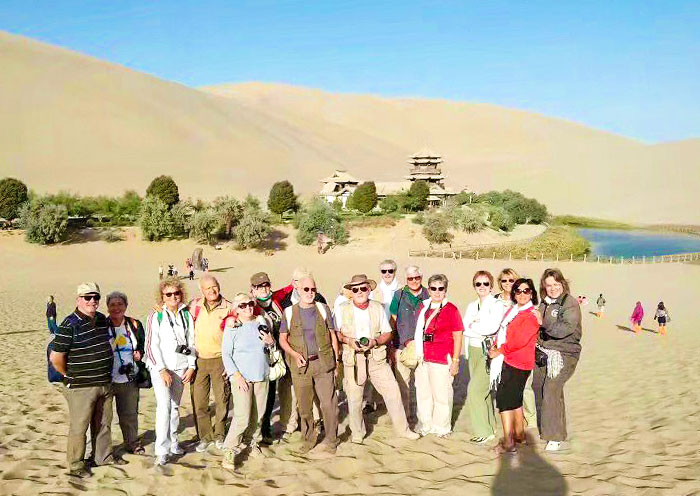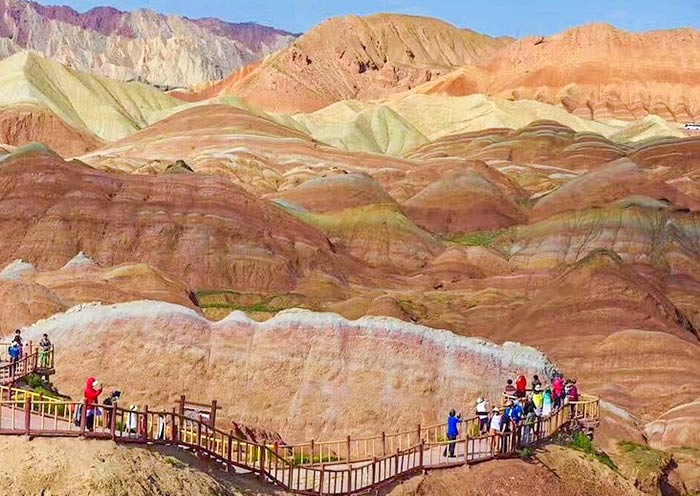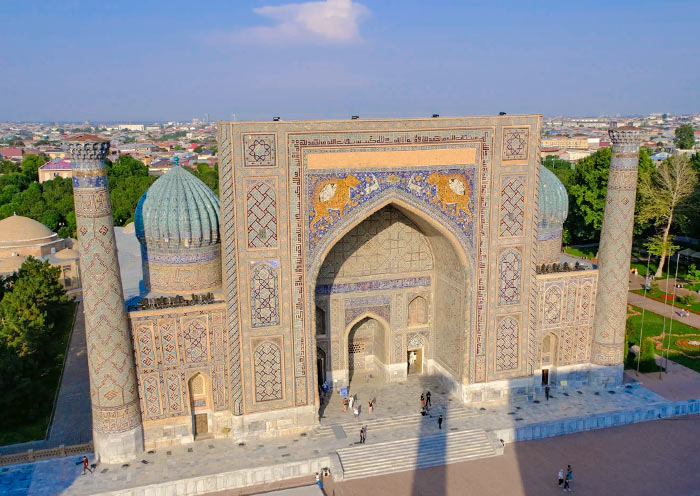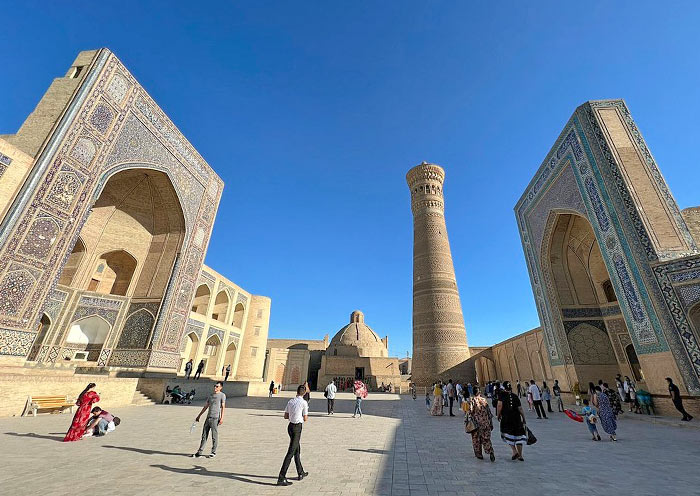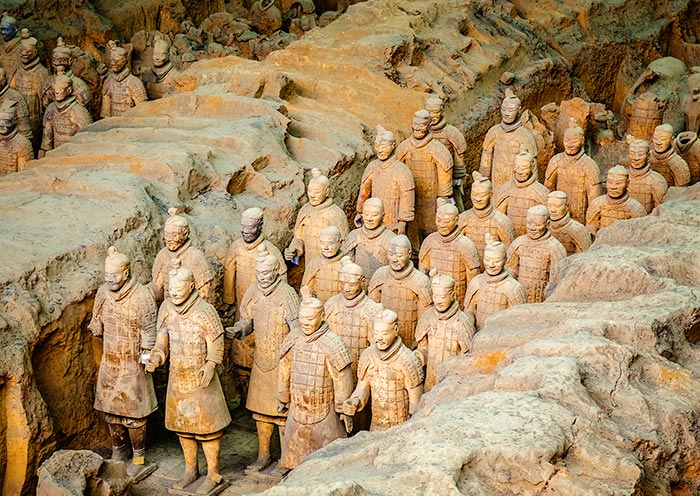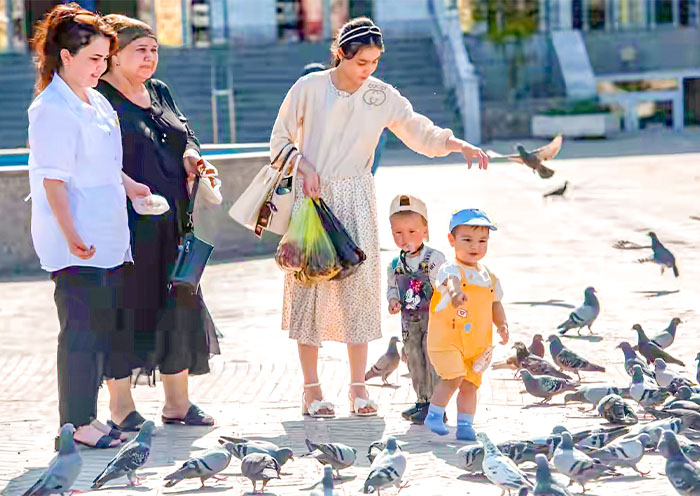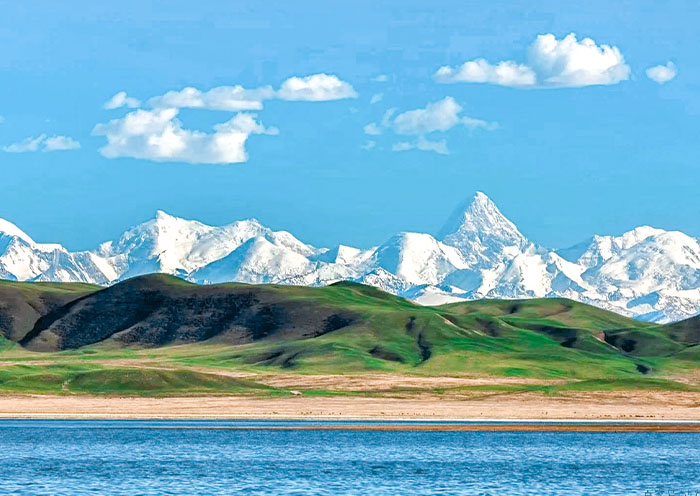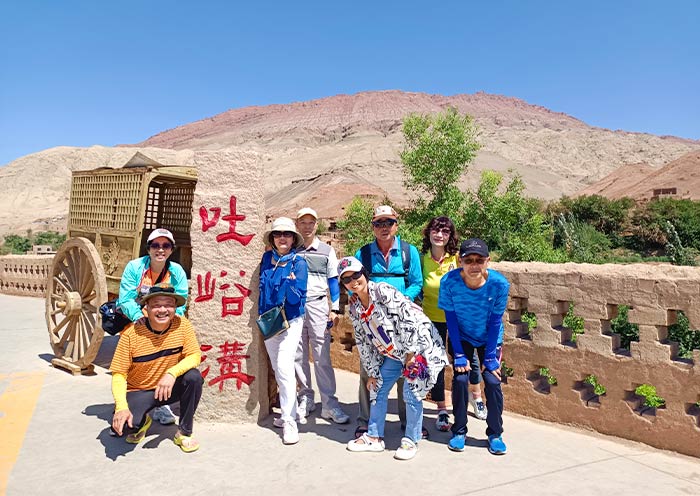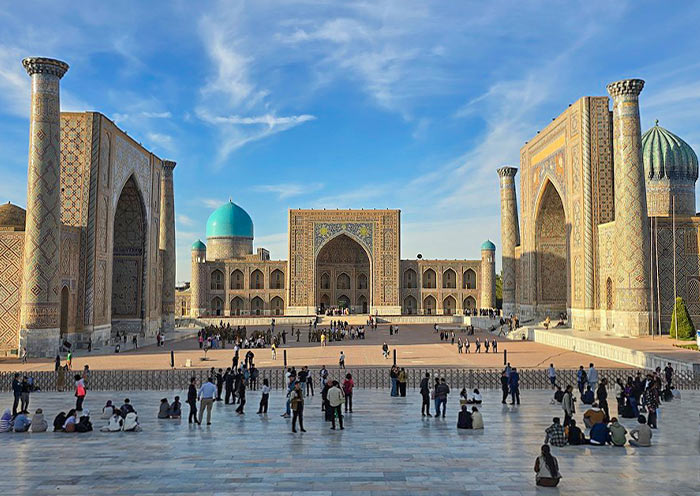The itinerary brilliantly captured the essence of the Silk Road, from Uzbekistan's majestic architecture to Tajikistan's rugged mountains and Turkmenistan's surreal desert craters. Our guide's expertise brought history alive, and our driver ensured a smooth, comfortable journey throughout. Impeccable service and an unforgettable deep dive into Central Asia's heart. Highly recommended!
19-Day Legendary Silk Road Tour: from China’s Xian to Uzbekistan (Core Route)
- Highlights
- Itinerary
- Price
- Trip Notes
- Accommodation
- Photos
- Reviews
UNESCO Silk Road Trail: Xi'an, Gansu, Xinjiang & Uzbekistan
Looking for an amazing, boundary-hopping journey? If you’re a history buff, culture enthusiast, photography lover, or Silk Road adventurer, don’t limit yourself to exploring a single destination. Make it complete!
Join us on this 19-day legendary Silk Road tour, a journey through three remarkable historical eras: the Golden Age of Chang’an (Xian), the spread of Buddhism (Dunhuang), and the Islamic Golden Age (Central Asia). This is an immersive experience of Silk Road heritage - COMPREHENSIVE yet ECONOMICAL.
From the glory of the Qin, Han, and Tang dynasties in Xian, to the pinnacle of Buddhist art in Dunhuang, and the grandeur of the Islamic Golden Age in Central Asia, you will truly experience an epic sense of history.
Explore over 10 UNESCO World Heritage Sites, including the Terracotta Warriors, Great Wall, Mogao Caves, Heavenly Lake of Tianshan, Khiva, Bukhara, and Samarkand. A true cultural feast!
Never tire of cultural exploration! Perfectly balanced with diverse landscapes - from China’s Loess Plateau, Danxia landforms, desert oases, and snow-capped lakes, to Central Asia’s deserts and the Amu Darya River - the scenery keeps the experience dynamic and exciting.
Cultural experiences are upgraded with AOT: Hanfu dressing, Shazhou Night Market, Heavenly Mountain hikes, and Samarkand bazaars. Have a deeper connection to local life.
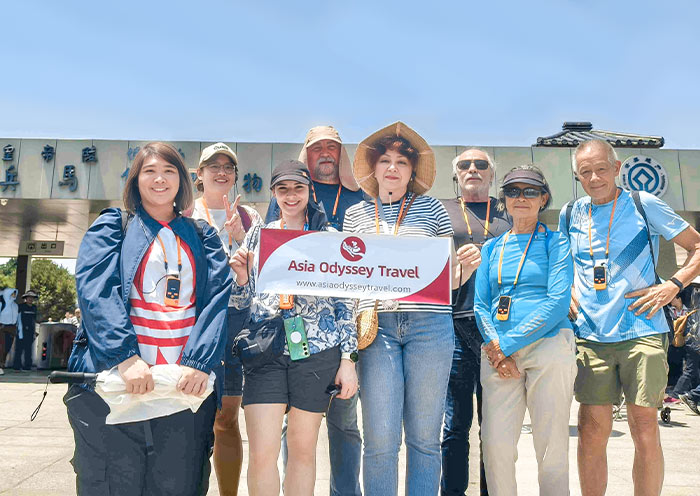
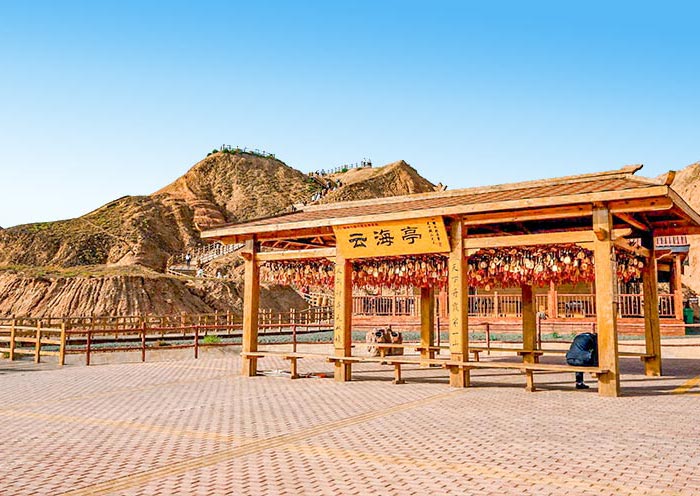
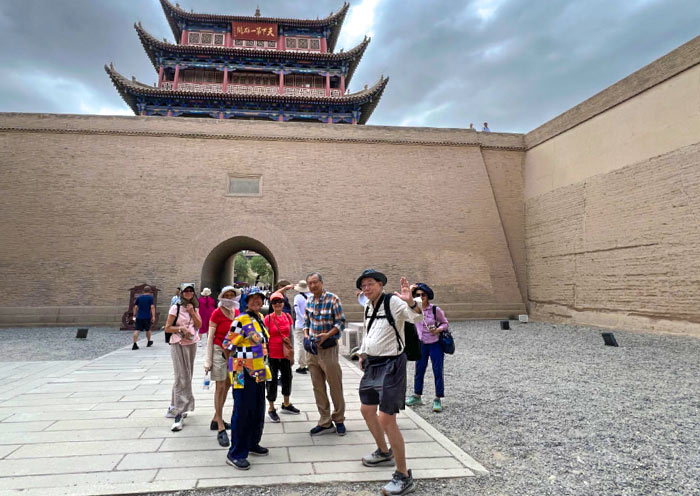
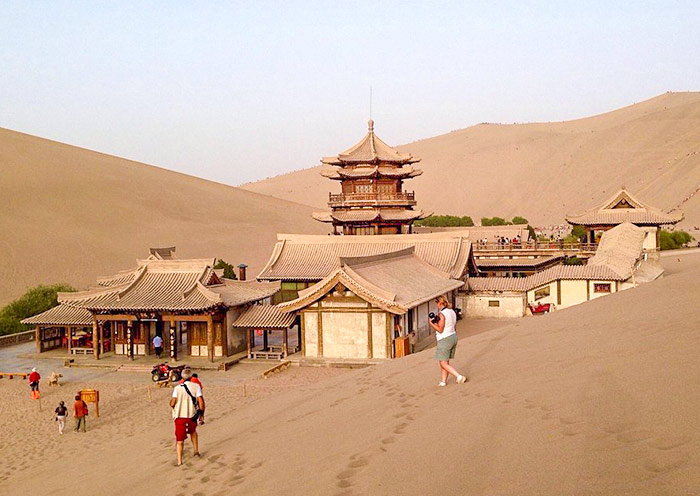
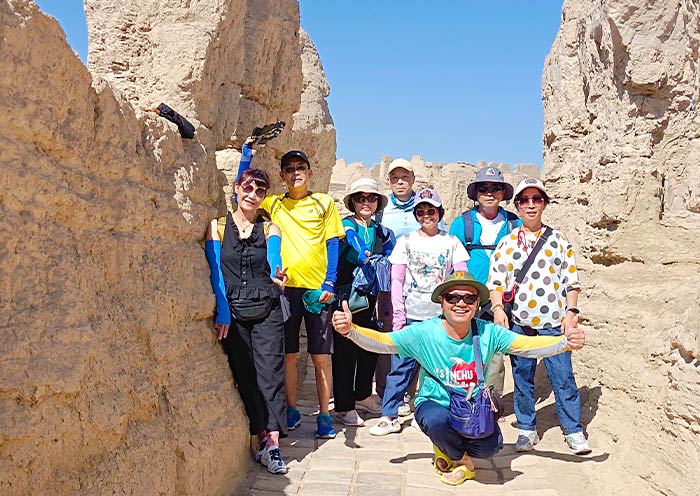
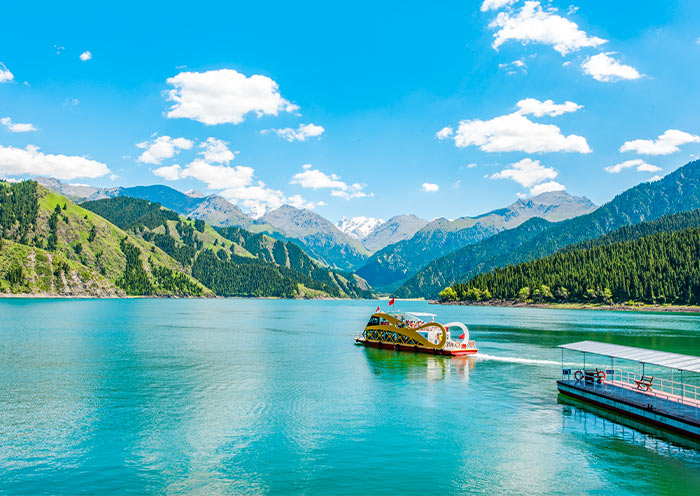
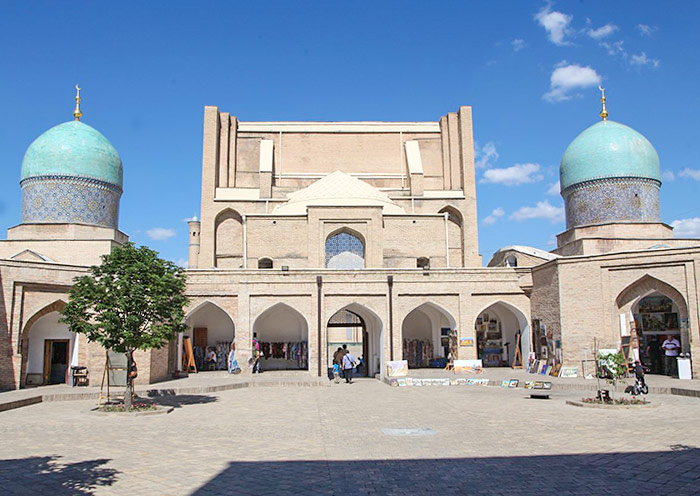
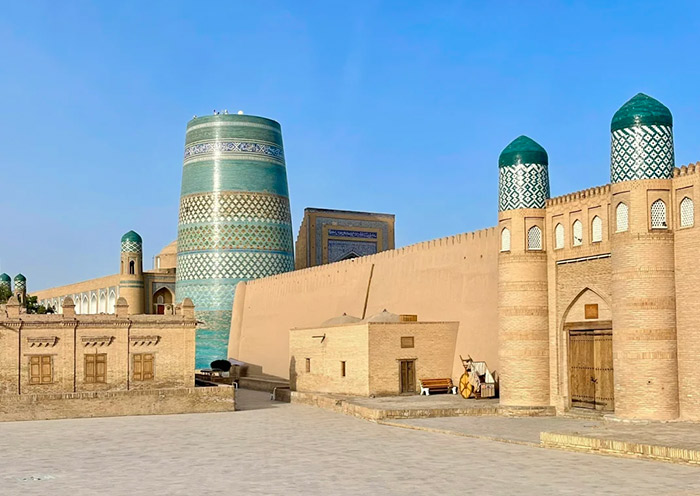
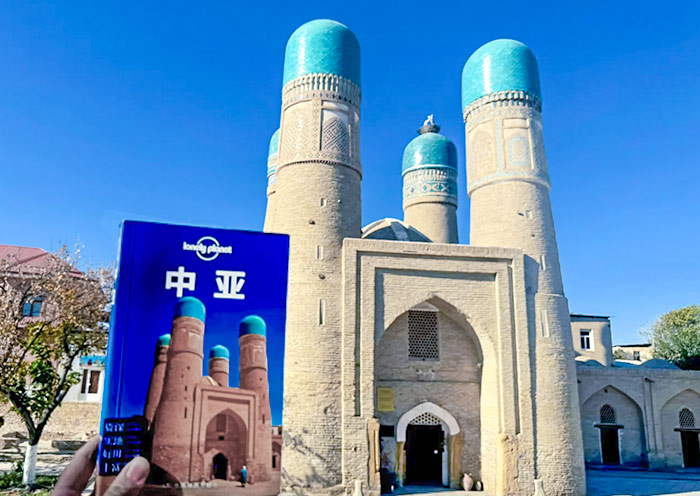
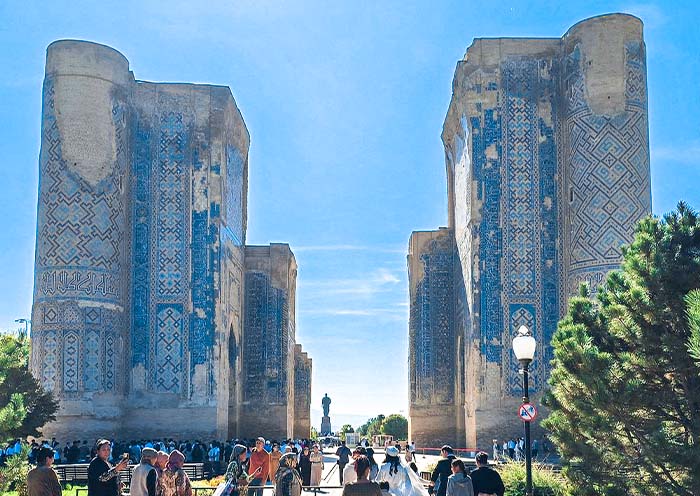
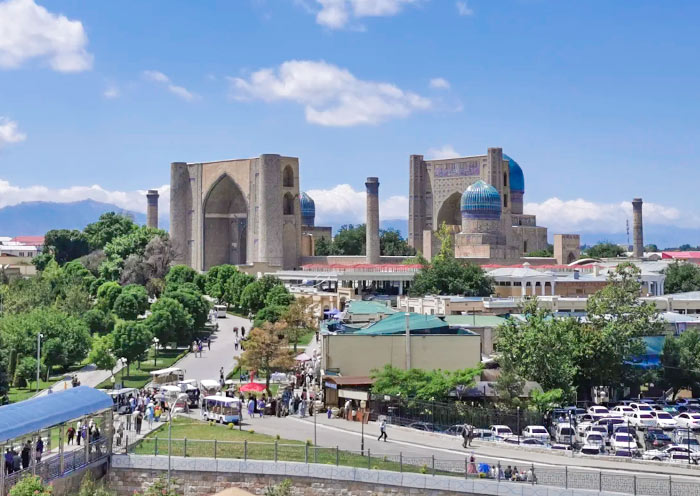
Itinerary at a Glance
Xian (3 Days)
erracotta Warriors, Ancient City Wall, Bell & Drum Tower, Muslim Quarter, Xian Museum, Ancient City Wall, Giant Wild Goose Pagoda, Hanfu Experience, Grand Tang Dynasty Ever Bright City
Zhangye (2 Days)
Transfer from Xian to Zhangye. Visit Dafo Temple (Big Buddha Temple), Zhangye National Geopark (Zhangye Danxia Geological Park)
Jiayuguan (1 Day)
Jiayuguan Pass (World Heritage - Great Wall of China), Great Wall Museum (Optional), Overhanging Great Wall
Dunhuang (1.5 Days)
Mogao Grottoes (World Heritage), Mingsha Mountain & Crescent Lake, Dunhuang Shazhou Night Market (Optional)
Turpan (1.5 Day)
Jiaohe Ancient City Ruins (World Heritage), Karez System, Emin Minaret
Urumqi (1.5 Days)
Heavenly Lake of Tianshan (World Heritage), Xinjiang Regional Museum
Tashkent (1.5 Days)
Fly to Tashkent from Urumqi. Visit Khast-Imam Complex (Hazrati Imam Complex), Chorsu Bazaar, State Museum of Applied Arts, Tashkent Metro (Soviet-era), Amir Timur Square
Khiva (2 Days)
Ichan-kala (Kalta Minor Minaret, Pakhlavan Makhmud Mausoleum, Islam Khoja Minaret, Juma Mosque, Tosh Hovli Palace, Kuhna Ark)
Bukhara (1.5 Days)
Chor Minor Madrasah (Four Minarets), Lyabi Hauz Ensemble (Afandi/Khodja Nasreddin Statue), Magoki Attori Mosque, Trading Domes, Po-i-Kalyan Complex (Kalyan Minaret), Ark of Bukhara (Ark Fortress), Bolo Hauz Mosque, Sitorai-Mokhi Khosa Palace (Summer Palace), Ismail Samani Mausoleum, Chashma-Ayub Mausoleum
Samarkand (2 Days)
Gur Emir Mausoleum (Timur’s Tomb), Registan Square, Bibi Khanim Mosque, Siyab Bazaar, Shahi Zinda Necropolis, Ulugh Beg Observatory, Khodja Doniyor Mausoleum (Tomb of Sait Daniel), Afrosiab Museum
Tashkent (1 Day)
Departure
Itinerary Day by Day
Nihao! Welcome to Xi’an, which served as the capital for 13 dynasties! Upon your arrival at the airport/train station in Xian, the tour guide and driver will meet and greet you at the exit, and then escort you to the well-selected hotel in downtown Xi’an. The rest of the day is free on your own so you can have a good rest for the jet lag or explore by yourself around your hotel.
Arrival Ideas:
Xi'an is well-connected by air and train. The city is served by Xian Xianyang International Airport, which offers domestic and international flights. You can easily reach Xi'an by air from major cities in China as well as from international destinations. Additionally, Xi'an is a major transportation hub with high-speed train connections to cities such as Beijing (4-5.5 hours), Shanghai (6-7 hours), Guangzhou (8.5-9 hours), Hangzhou (7-8 hours), Pingyao (3 hours), Chengdu (4 hours), etc, allowing for convenient travel.
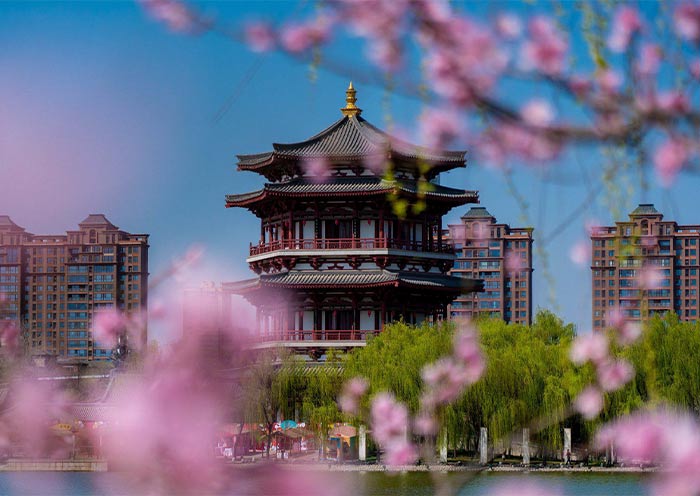
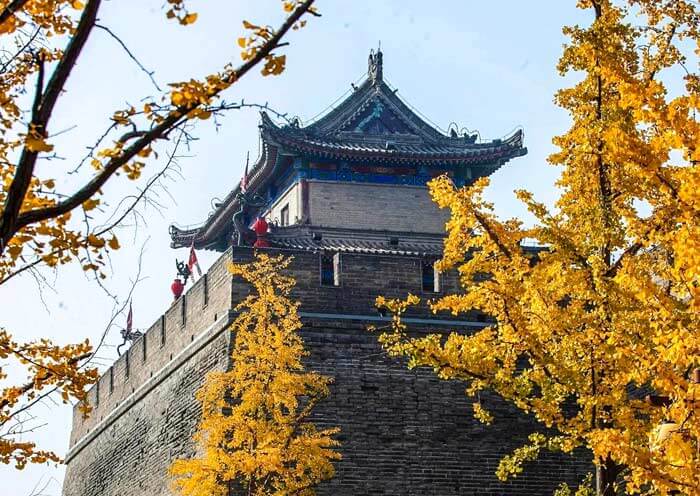
After breakfast, your guide and driver will pick you up at your hotel. Drive about 40km (about 1 hour) to uncover one of the greatest archaeological discoveries in the world - the Terracotta Army Museum, built by the first emperor of China, Qin Shihuang, to protect him in the afterlife. Around 8,000 vivid life-size Terracotta Warriors have been found so far. First, visit the largest and most imposing pit, believed to contain over 6,000 terracotta figures of soldiers and horses. You will be amazed by this subterranean life-size army of thousands standing silently to guard the emperor. Marvel also at the fabulous artistic skills of ancient Chinese artisans. Next, move to another pit where you can see around 1,300 warriors and horses. Examine the ancient army formation, including the kneeling and standing archers, the chariot war array, and numerous troopers holding weapons.
After lunch, head to visit the Ancient City Wall, also known as the Fortification of Xian, representing one of the oldest, largest, and best-preserved Chinese city walls. Spend time leisurely walking the wall and enjoying its inner and outer walls, watchtowers, and moat, taking in panoramic views of modern Xian, there, you will also visit the awe-inspiring Bell Tower and Drum Tower, both landmarks from the Ming Dynasty dating back 600 years, will be beautifully illuminated, creating a captivating backdrop for stunning photos showcasing the harmonious blend of ancient history and modernity in Xian. In the evening, you may also have the chance to witness the enchanting musical fountain and lively square dancing near Bell & Drum Tower Square (Zhongulou Square), allowing you to immerse yourself in Xian's vibrant nightlife like a local.
Once you've delved into the city's historical narrative, don't forget to indulge in the delicious food and experience the vivid local life. The Muslim Quarter is a paradise mixed with different local snacks and Muslim culture, and you can surely taste the most authentic local food there. Don't miss the Great Mosque, an architectural gem that beautifully blends Islamic and Chinese design styles.
After the tour, be escorted to your hotel in Xian.
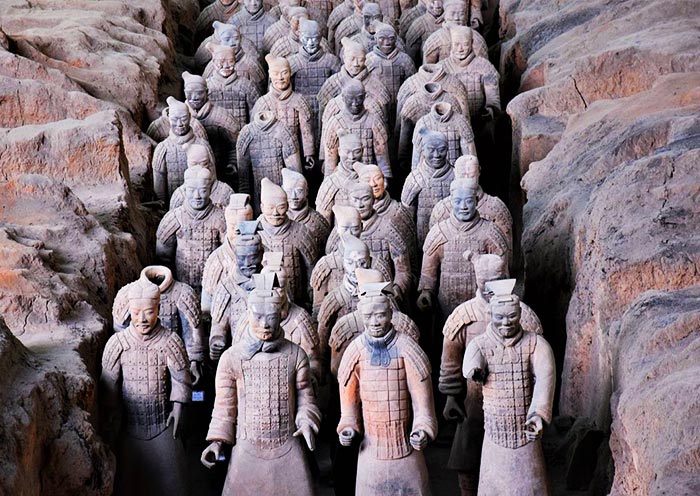
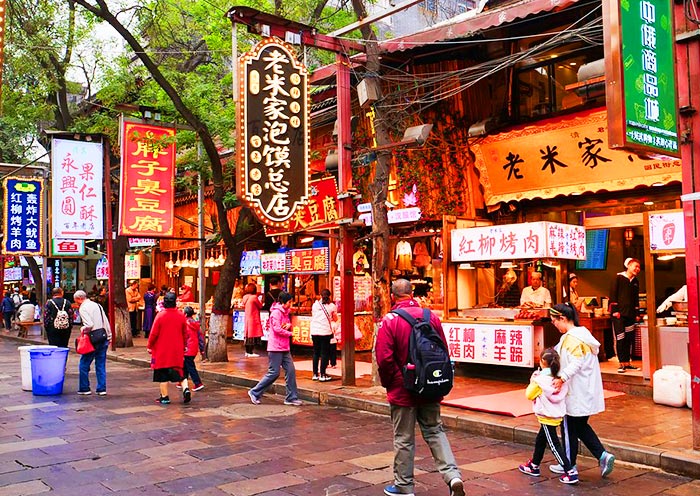
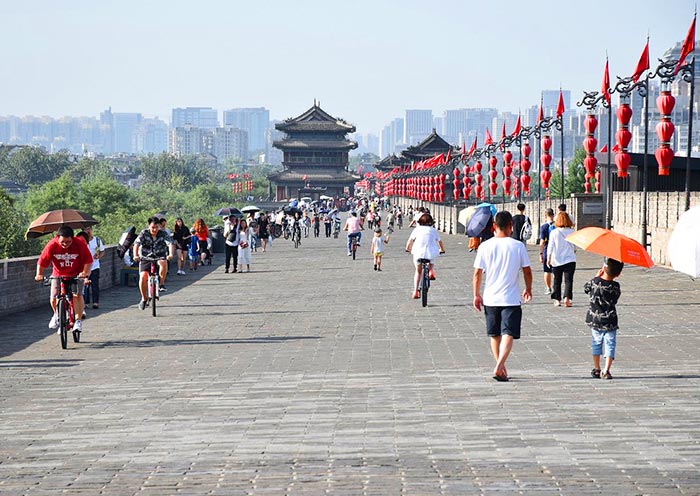
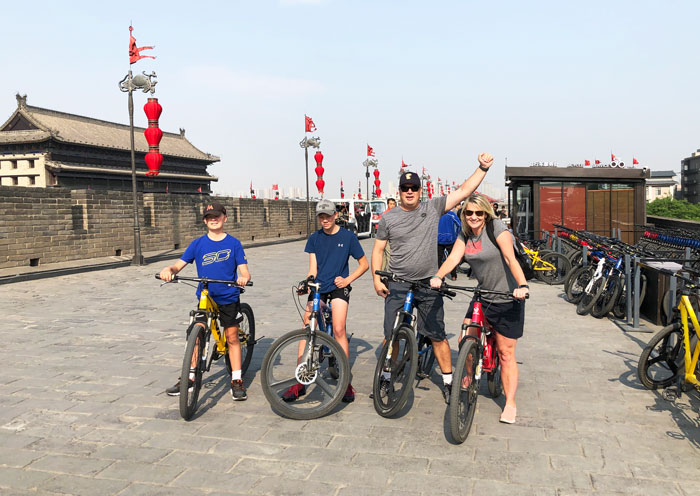
This morning, drive to visit the Xian Museum (Closed on Tuesday). It is one of the top museums in China, showcasing the 3,000-year history of Xian, the one-time capital of 13 dynasties, its economy, social life, as well as cultural exchange and trade with foreign countries. The museum is less crowded than the Shaanxi History Museum. The famous architect Zhang Jinqiu, who also designed the Shaanxi History Museum, designed this building. Its architectural design symbolizes the traditional Chinese concept of the universe - a round heaven and a square earth. With more than 110,000 pieces of cultural relics, including bronze wares, jade wares, gold and silver wares, three-color glazed wares, painting and calligraphy, miscellaneous wares, seals, Buddhist statues, stone carvings, porcelains, etc., the Xian Museum has achieved a wide reputation and popularity for its historical and cultural value. In fact, the Xian Museum is made up of an exhibition hall, the site of the Jianfu Temple in the Tang Dynasty, and the Small Wild Goose Pagoda.
Before entering the Xian Museum, you can enjoy a nice view of Jianfu Temple and its Small Wild Goose Pagoda. The Jianfu Temple used to be a royal temple of the Tang Dynasty (destroyed by war) and was rebuilt during Ming and Qing dynasties. The logo of the Xian Museum is designed based on the Small Wild Goose Pagoda, which shows the long history of the Xian Museum and the profound Chinese culture.
Then, move to Giant Wild Goose Pagoda (Big Wild Goose Pagoda) for a Hanfu Costume Experience. Hanfu is the traditional clothing of the Han Chinese, the predominant ethnic group of China for thousands of years. Hanfu is a significant symbol of Chinese civilization, and different stages of Hanfu's development correspond to different Chinese dynasties. Choose your preferred Hanfu and wear it to walk around the Giant Wild Goose Pagoda like the people from the Tang Dynasty. Traditional Hanfu fashion is in vogue now, and you will encounter many locals wearing beautiful Hanfu as you stroll through the courtyards, taking beautiful photos. Enjoy your Hanfu cultural tour inside the ancient buildings while gaining a better understanding of Hanfu, Chinese history, and culture.
The Big Wild Goose Pagoda (World Heritage), built about 1,370 years ago, is one of Xian's most recognizable landmarks and a symbol of the magnificence of the Tang Dynasty. This 7-story pagoda, standing in the tranquil Da Ci'en Temple, is one of China's best examples of a Tang-style pagoda (squarish rather than round). It was completed in AD 652 to house Buddhist sutras brought back from India by the monk Xuan Zang. His travels inspired one of the best-known works of Chinese literature, Journey to the West. Your guide can provide more information about Xuanzang, who set off from Chang'an (the ancient Xi'an) along the Silk Road, spent 17 years traversing 100 countries, and finally arrived in India, the cradle of Buddhism.
As evening falls, you won't want to miss the Largest Musical Fountain in Asia, located at the North Square of the Big Wild Goose Pagoda. The North Square of the Big Wild Goose Pagoda Music Fountain is controlled by a computer, and the fountains shoot streams of water that vary in height and shape in accordance with the rhythm of music (Water Phantom of Tang). The night view is especially breathtaking when the fountain is illuminated by LED lights.
After enjoying the "dance of water", it's time to visit the Grand Tang Dynasty Ever Bright City, which is located south of the Giant Wild Goose Pagoda and west of Tang Paradise. It is a 1,500-meter-long pedestrian street themed with Tang Dynasty culture, featuring buildings with Tang Dynasty (618 - 907) architecture and sculptures telling Tang stories. You can enjoy street performances, a variety of Xi'an food, and shopping here. It creates an immersive atmosphere to take you back to Tang Dynasty, providing a magical experience of walking through time. The best time to visit is at night, after the lights are lit up and people start to gather for fun. It is a place where people can embrace old and new cultures.
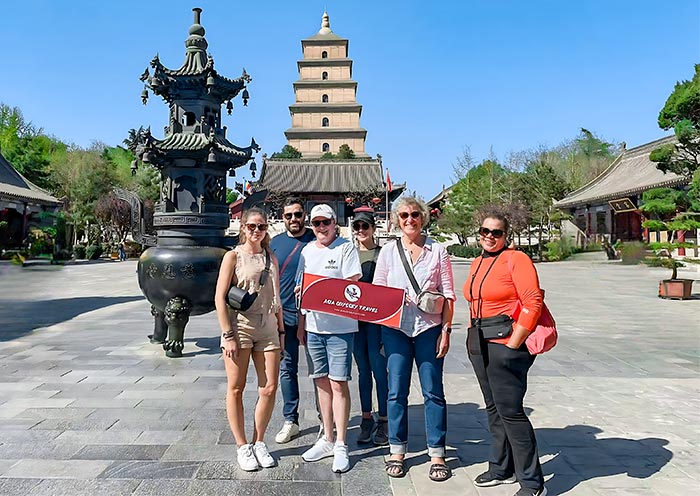
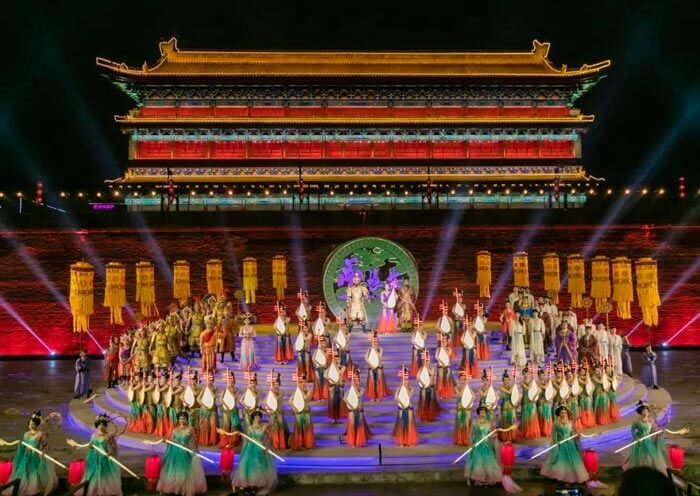
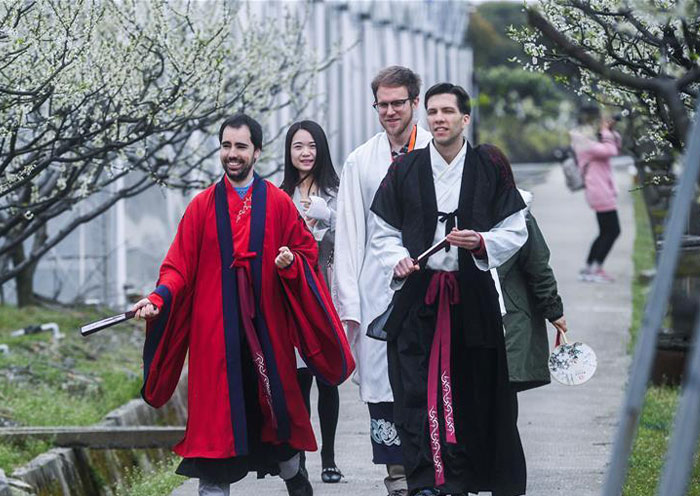
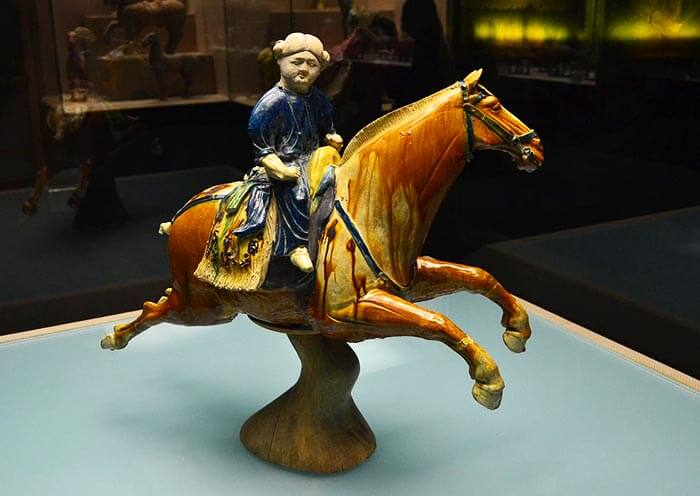
Today, you’ll take high-speed train from Xi’an to Zhangye, a scenic journey of about 6 to 6.5 hours across the vast landscapes of northwest China.
Travel Tip:
If there’s a suitable flight available from Xi’an to Zhangye, we’ll compare the schedules and fares - you may opt for the 2-hour flight instead for quicker transfer.
Zhangye, once an important hub on the ancient Silk Road, holds deep historical and cultural significance. It was a key stop for the Tang Dynasty monk Xuanzang on his legendary pilgrimage to the West in search of Buddhist scriptures - a journey that inspired the famous tale Journey to the West.
In the evening, explore Zhangye’s lively night market, where you can taste the city’s specialties such as tender donkey meat and refreshing apricot skin tea. It’s the perfect way to experience the authentic local flavor and unwind after your travel.
Overnight in Zhangye.
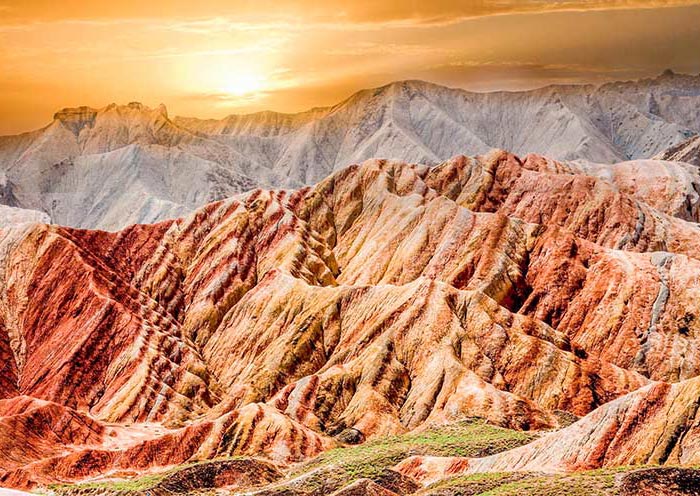
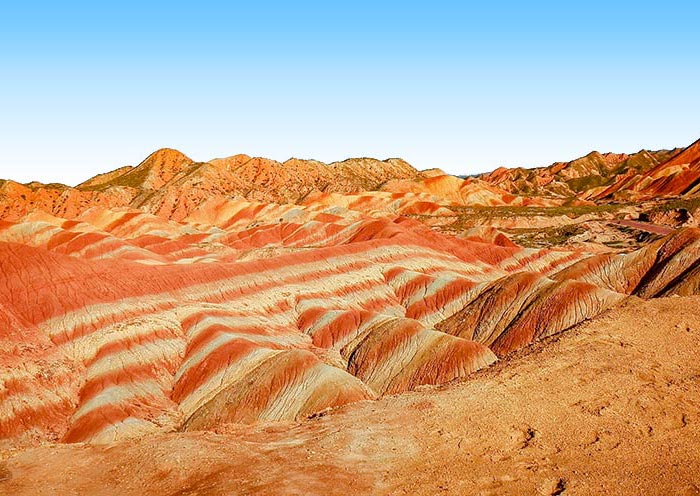
Today, you will explore Zhangye City through Dafo Temple (1-2 hours) & Zhangye Danxia National Geological Park (3-4 hours) before heading to Jiayuguan (260 km, 4hrs). It is a long day trip, when reach Jiayuguan, you can have a good rest at your hotel.
Dafo Temple (大佛寺; Big Buddha Temple) is a must-visit place in Zhangye if you are particularly interested in Buddhist culture and ancient architecture. The Big Buddha Temple is the iconic building of Zhangye, known for housing a 34.5-meter-long statue of the reclining Buddha, commonly called the "Reclining Buddha Temple 卧佛寺" by locals. Built in the year 1098, the Giant Buddha Temple was a royal temple built by the Western Xia Dynasty (西夏;1038-1227), making it one of the Four Remaining Royal Temples in China (the other three being the Lama Temple in Beijing, the Famen Temple in Baoji Of Shaanxi, and the Chongsheng Temple in Dali Of Yunnan). Legend has it that Kublai Khan (忽必烈), the founder of the Yuan Dynasty (1271-1368), was born in the Big Buddha Temple in Zhangye. The Italian traveler Marco Polo was captivated by the magnificent architecture of the Giant Buddha Temple and the prosperity of Zhangye, leading him to stay there for a year. Covering an area of over 60,000 m², the temple could accommodate 5,000 worshipers simultaneously in the 16th century.
Visit Big Buddha Temple in Zhangye to explore the only surviving Western Xia temple in China, the largest indoor reclining Buddha in Asia, and the complete Yongle Canon and Prajna Paramita Sutra (《永乐北藏》). It is a Buddhist art museum that integrates architecture, sculpture, murals, carvings, scriptures, calligraphy, and cultural relics. When you step into the temple, you'll see the Grand Buddha Hall which has maintained its original appearance from over 900 years ago. Besides the reclining Buddha, the walls on the east and west sides of the hall feature murals inspired by "Journey to the West西游记," "Investiture of the Gods封神演义," and the "Classic of Mountains and Seas山海经." Among these, the "Journey to the West" mural is said to predate the novel by approximately 200 years, depicting the story of Tang Dynasty Monk Xuanzang (唐僧) and his disciples embarking on their journey to the West in a comic strip format, showcasing episodes like "Fetching Water from the Motherhood River," "A Battle with Red Boy," "Obstacle at Flaming Mountain," "The Monkey King: Uproar in Heaven," and "Expulsion of the Monkey King/Wukong" (取水子母河、大战红孩儿、路阻火焰山、大圣闹天宫、恨逐美猴王). Interestingly, the character Zhu Bajie (猪八戒) in the mural is portrayed as simple, honest, and hardworking, in stark contrast to the Zhu Bajie character in the novel Journey to the West. Even today, within the Zhangye region, one can find many place names from the novel Journey to the West, such as Gaolaozhuang (高老庄Bajie's hometown), Liusha River (流沙河), Liangjintai (晾金台), Bull Demon King's Cave (牛魔王洞), and the Eight Thousand Ruoshui River(八千里弱水).
A pair of Chinese characters written on a couplet outside the Grand Buddha Hall reads, "The Sleeping Buddha slumbers a thousand years without awakening, those who inquire will forever question, the answer remains elusive睡佛长睡睡千年长眠不醒,问者永问问百世永问难明," provoking deep contemplation and worth a look. Remember to ask the guide to show you another pair of couplets written in the Western Xia script with the same content. Additionally, the scripture hall of the reclining Buddha temple houses a Buddhist art exhibition hall and a Buddhist scripture exhibition hall, showcasing Buddhist artifacts extracted from the Buddha's abdomen. Among them, the "Mahaprajnaparamita Sutra《大般若波罗蜜多经》" written in gold and silver ink is a treasured artifact. Rare and exquisite Persian silver coins have been discovered in this temple, serving as compelling evidence of the bustling foreign trade along the Silk Road.
Optional Visiting Place: (If Time Permits)
1. Shanxi Guild Hall (山西会馆) : Located next to the Big Buddha Temple, the Shanxi Guild Hall was constructed by Shanxi merchants (晋商) in 1724 with a history of over 300 years for their commercial activities in Zhangye. It is said that "where there is prosperous trade, there are Shanxi merchants; where there are Shanxi merchants, there are guild halls凡商贸繁华处必有晋商,有晋商居处,必有会馆." During the Ming and Qing dynasties, Shanxi merchants built around 400 Shanxi Guild Halls across the country, all characterized by the presence of a Guan Gong Temple (关帝庙; dedicated to Guan Yu拜关羽) and an Opera Stage (西楼).
2. Zhangye City Museum (张掖博物馆Closed on Mondays): Located opposite the Zhangye Big Buddha Temple, the Zhangye City Museum houses over 10,000 cultural relics spanning various historical periods from the Neolithic Age to the Ming and Qing Dynasties. These relics are diverse and include bronze ware, pottery, jade artifacts, as well as cultural remnants from the Silk Road. You can admire a 1:1 replica of the Golden Tower Temple grottoes (金塔寺1:1复制石窟) in this museum.
Note:
Currently, the reclining Buddha statue in Zhangye Giant Buddha Temple is undergoing digital restoration, covered by scaffolding. The project is expected to be completed by June 2025.
After lunch, head to visit Zhangye National Geopark (Zhangye Colorful Danxia Scenic Spot七彩丹霞景区) which is renowned for its strikingly colorful rock formations, often referred to as Rainbow Mountains. Zhangye is famous worldwide for its colorful Danxia landforms, a must-visit attraction for people traveling to Zhangye. This is a paradise for geologist & photography enthusiasts, and a great place to experience the marvelous work of nature. The Zhangye Colorful Danxia Scenic Spot (七彩丹霞景区), part of the Zhangye National Geopark, is China's only highly composite area that combines Danxia landforms with colorful hilly landscapes. Zhangye Danxia has been honored as one of the world's top ten geographical wonders, one of the 22 most unforgettable landscapes worldwide, and the most beautiful exterior filming location at the 74th Venice Film Festival. This location served as a filming site for the movie The Great Wall《长城》 directed by Zhang Yimou and Disney's Mulan《花木兰》. The Rainbow Mountains featured on the cover of high school English textbooks are not only geological relics of special scientific significance, rarity, and aesthetic value but also hold archaeological, ecological, historical, and cultural significance.
During the Cretaceous period, approximately 135 to 65 million years ago, the Zhangye region underwent the Himalayan orogeny, multiple erosions by water and wind, and long-term weathering processes, leading to the formation of the current Danxia landforms. The strata are mainly composed of sandstone and mudstone, formed in a dry and hot environment, where divalent iron in minerals oxidized to trivalent iron, giving the strata a red hue. As the environment gradually became wetter, the high-priced iron was reduced, causing a change in strata color to shades of brown, yellow-green, and bluish-gray, creating a palette resembling that of an overturned divine paintbox. The term "Danxia (丹霞)" originates from Cao Pi's poem (曹丕) "Danxia surrounded by the bright moon, with splendid stars emerging amidst the clouds (丹霞夹明月,华星出云间)." "Danxia," literally means the sacred or auspicious celestial sight - the rosy clouds illuminated by light. When geologists first discovered the cinnabar-colored landform, the romantic scientists named it the "Danxia landscape," leading to the coinage of the geographical term "Danxia landform (丹霞地貌)."
The scenic area comprises five Observation Decks (No. 3 and No. 2 have been merged). Shuttle buses connect each Observation Deck (entering and exiting at the north gate, with shuttle stops at four points in the order of Observation Deck #2-1-5-4). Observation Deck #1 and Observation Deck #4 are the most recommended. Yunhai Platform (云海台 No. 1) is where the image was taken on the ticket and the largest viewing platform, offering a panoramic view of the entire Danxia landscape, including the winding S-shaped road. Hongxia Platform (虹霞台 No. 4), highly popular and considered the most beautiful spot with the most vibrant colors, is the best place to watch the sunset. In the eyes of the Chinese people, the Rainbow Mountains here resemble delicious Pork Belly or Strawberry Cake layers.
At the Zhangye Rainbow Mountains, you can admire unique features like the Rainbow Screen, Sleeping Beauty, Giant Scallop, Monks Worshiping Buddha, Monkey Gazing at the Sea, Turtle Asking the Heavens, and the Red Cliff Great Wall (七彩屏、睡美人,大扇贝、众僧拜佛、灵猴观海、神龟问天、赤壁长城). Standing at the mountaintop, one can witness the colorful watercolor-like mountain ranges, feeling as if stepping into a painting.
After visiting Zhanghe, head to Jiayuguan (210km, 3hrs) via Jiuquan City (酒泉). If time permits, you can arrive at the Great Wall on the Cliff before 17:00 to hike and witness the sunset at Great Wall of Jiayuguan. Jiayuguan is a good place to grasp the essence of a famous Chinese poem that goes, 'In the boundless desert, lonely smoke rises straight; Over the endless river, the sun sinks round大漠孤烟直,长河落日圆'. Overnight stay in Jiayuguan.
Optional Visiting Place:
Zhangye UNESCO Global Geopark Museum (张掖地质公园博物馆 Closed on Mondays): You can enter from the North Gate (北门) as it is where the Zhangye UNESCO Global Geopark Museum (Closed on Monday) located. With a visit to the museum that serving as a popular science base for understanding the professional knowledge of Zhangye Danxia Landform, you may gain deeper understanding of this Zhangye Danxia National Geological Park (Zhangye Danxia Geopark张掖国家地质公园).
Notes:
The best time for photography is at sunrise when the light is soft, colors are vivid, and there is a strong contrast, ideal for capturing both the panoramic view and detailed textures of the Rainbow Mountains. Sunset, with the setting sun casting its warm glow on the hills, creating golden silhouettes, is also an excellent time to capture the beauty of the Rainbow Mountains. If you want to capture the sunrise, do double check with your travel consultant to overnight at the hotel near the Rainbow Mountains.
Another optimal time to appreciate the Danxia landforms is after rainfall when the colors become even more vibrant and captivating due to the moisture.
Comfortable shoes are essential as climbing uphill sections may occur.
The scenic area also offers entertainment options such as camel rides, hot air balloons, gliders, helicopters, and other activities (at an additional cost).
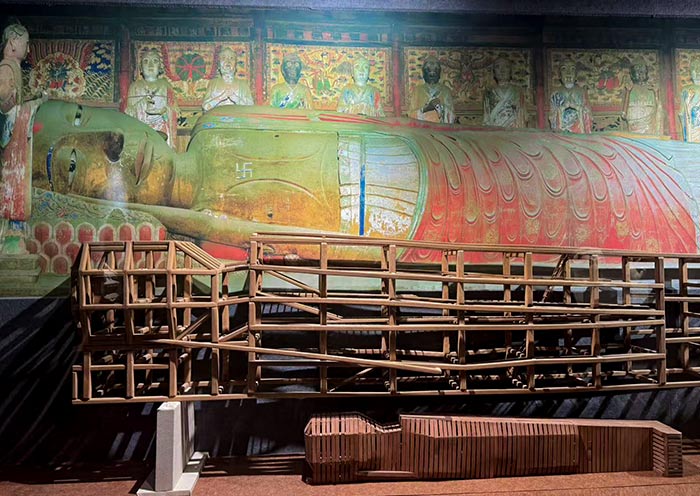
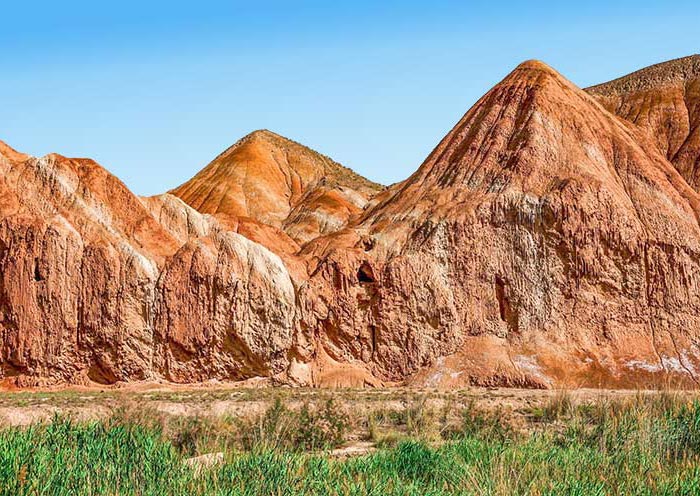
Today, you will explore Jiayuguan City for the Jiayuguan Pass (Jiayuguan Fortress) & Great Wall on the Cliff (Overhanging Great Wall). Then, head to Dunhuang (400 km, 5hrs).
Jiayuguan Pass (嘉峪关关城), built in 1372, is known as one of the "Three Great Passes of the Great Wall of China中国长城三大奇观之一" (Shanhaiguan Pass in the east, Zhenbeitai Terrace in the middle, and Jiayuguan Pass in the west). Standing atop the Jiayuguan Pass, a part of the UNESCO World Heritage Site "The Great Wall of China", you can feel the magnificence and grandeur of this ancient military defense structure. Jiayuguan is the Westernmost Pass of the Ming Great Wall, in the middle of the Hexi Corridor. "Jiayu" means "beautiful valley." Nestled against mountains and water, with its strategic location and majestic architecture, it is renowned as the "The Impregnable Pass under Heaven天下第一雄关."
From the Jiayuguan Pass walls, you can see the Great Wall traversing the desert and the Gobi, while the beautiful Qilian Mountains (祁连山Snow Mountains) and the Heishan Mountains (黑山) act as natural barriers, stretching across the north and south of Jiayuguan. The magnificent scene described in the elementary school Chinese textbook "The Great Wall《长城》" - "From Shanhaiguan in the east to Jiayuguan in the west, spans over 13,000 li (Chinese miles)从东头的山海关到西头的嘉峪关,有一万三千多里" - finds perfect embodiment here.
You might imagine over 600 years ago when this place was a battleground where the Great Walls were built and met with the Ancient Silk Road, connecting the Central Plains (中原) with the Western Regions (西域), and witnessing numerous commercial exchanges and cultural interactions. During the Western Han Dynasty (202 BC-8 AD), Zhang Qian (张骞) passed through here three times to open up the Western Regions, and General Huo Qubing (霍去病) departed to battle the Huns, or Xiongnu (匈奴). During the Tang Dynasty (618-907), Monk Xuanzang (玄奘) passed through here to retrieve Buddhist scriptures. Marco Polo (马可波罗) traveled through China in the Yuan Dynasty (1206-1368) and visited Jiayuguan. In 1841 (Qing Dynasty), Lin Zexu (林则徐) was sentenced to exile in Yili, Xinjiang for his involvement in the anti-opium campaign. Passing through Jiayuguan, he composed the poem "Southeast, who compares to this mighty pass东南谁比此关雄."
Today, in Jiayuguan Fortress, you can obtain a passage permit (Optional; Self-pay) and experience the process of entering and exiting Jiayuguan as it was centuries ago. This unique experience transports you through time, back to an era where official "passes" (an early form of passport) were required for passage. The Chinese phrase "qing duo guanzhao " (请多关照literally means please take care of me; similar to nice to meet you) originates from the polite language used by people entering and exiting Jiayuguan, symbolizing mutual care and assistance.
Jiayuguan Pass/Fortress is one of the best-preserved gate cities along the Great Wall, making it a popular destination for architecture enthusiasts. It consists of three overlapping defense lines - the inner city, outer city, and moat - forming a military defense system with watchtowers every five li, beacon towers every ten li, fortresses every thirty li, and a city every hundred li. Jiayuguan is not just a city; it's a legendary tale waiting for you to uncover its secrets. Additionally, Jiayuguan is an oasis at the foot of the Qilian Snow Mountains, with numerous lakes and lush greenery, making it a rare summer retreat.
After that, it is time to climb the Great Wall on the Cliff (Overhanging Great Wall悬壁长城) which was acclaimed as the "end of the Great Wall". It was constructed in 1539 (Ming Dynasty) and only 750 meters remain. As the northern extension of the Jiayuguan Pass, it was built following the natural terrain, using local gravel and loess, the steepest section reaches about 45 degrees (over 200 m), earning its name for its appearance of hanging upside down in the air. After renovations in 1987, it consists of parapets, crenellations, and platforms. Two additional platforms were added at both ends, totaling three platforms. Climbing along the Great Wall trail (over 400 steps; kid-friendly ) to the highest watchtower, you can admire the magnificent scenery both inside and outside the Great Wall. From the desert landscapes beside the expressway to the towering chimneys in the oasis, every sight is breathtaking. Here, you can discover the remnants of ancient warfare and beacon fires while marveling at the wisdom of ancient military defense and the rapid development of modern civilization.
Then, head to Dunhuang via Guazhou. Dunhuang, a city in Jiuquan (酒泉市), which was formerly known as Suzhou (肃州), is the birthplace of the "su" character in Gansu Province (甘肃的“肃”).
Optional Visiting Place:
1. Jiayuguan Museum of The Great Wall (嘉峪关长城博物馆): It is located near the Jiayuguan Pass. As the first museum in China to theme on the Great Wall, established in 1989, its exhibitions are divided into four sections: the history of the Great Wall, the military aspects of the Great Wall, the Hexi Corridor section of the Great Wall and the Silk Road, and the ancient and modern aspects of the Jiayuguan Pass. One of the prized possessions in the museum is the "Wild Boar's Hoof," dating back 2,000 years.
2. The First Outpost of the Great Wall (长城第一墩; Self-pay):Located on the way to Dunhuang, the First Outpost of the Great Wall, standing about 10 m high, rises on a cliff about 56 m high near the Taolai River (讨赖河). It is the westernmost platform of the Ming Dynasty Great Wall (墩台; ancient military communication spot). You can witness the historical relics in their original state. With a little walk, you will discover an ancient military camp by the river valley where you can immerse yourself in the harsh lives of the frontier soldiers of that era.
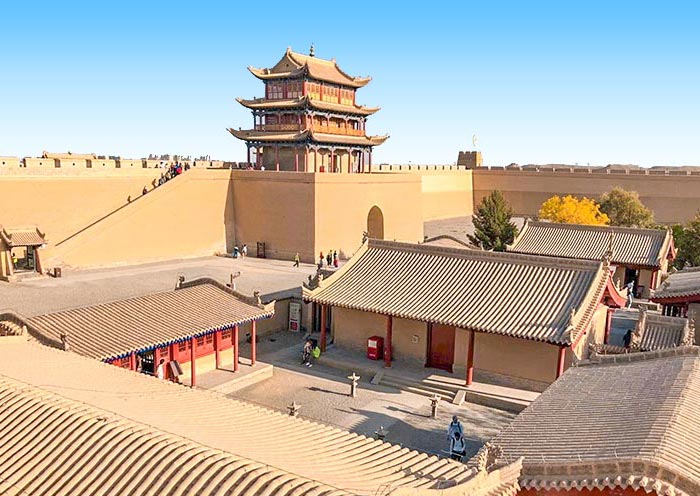
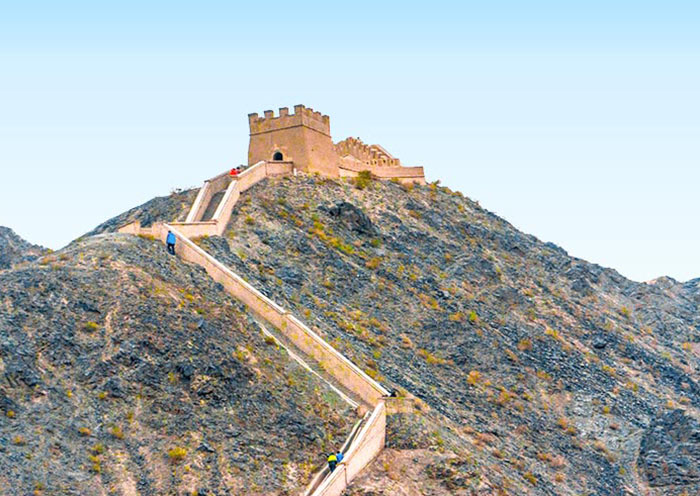
Today, you will enjoy a wonderful Dunhuang Culture Tour by visiting Mogao Grottoes (4-4.5hrs), a UNESCO World Heritage site. You can enjoy the relaxing time in Echoing Sand Mountain & Crescent Lake, don’t miss the delicious food at the Shazhou Night Market.
Dunhuang Mogao Grottoes is the must-visit place for a trip to Gansu. You may read many stories about A. Stein (斯坦因a British archaeologist and explorer) and the vast trove of artifacts (Paintings, Sculptures, Manuscripts) he brought from the Mogao Grottoes in the early 20th century. You may have already seen the artifacts Stein collected in the British Museum in London. Or you may have heard of Paul Pelliot (French archaeologist & Sinologist) who like A. Stein, conducted several expeditions to Dunhuang and collected a large number of artifacts which is primarily housed in the Guimet Museum in Paris, France. Welcome to visit Mogao Grottoes the source of the world famous Dunhuang Manuscripts (Dunhuang Yi shu敦煌遗书; Cave 16-17) and explore valuable insights into the history and culture of the Silk Road.
The Mogao Caves (Mogao Grottoes莫高窟), also known as the Thousand Buddha Grottoes (千佛洞), are acclaimed as the "Treasure House of Eastern Art东方艺术宝库." The remaining 735 caves are dotted along cliffs rising about 15-30 m high and over 1,700 m, forming a magnificent spectacle of this world cultural heritage site. Despite the significant loss of artifacts to oversea museums, the Mogao Caves remain one of the world's largest and most richly endowed repositories of Buddhist art. Spanning sixteen kingdoms, Northern Wei, Western Wei, Northern Zhou, Sui, Tang, Five Dynasties, Song, and Western Xia dynasties, the construction of the Mogao Grottoes lasted for over a thousand years until the Yuan Dynasty, resulting in about 45,000 ㎡ murals and 2,415 clay sculptures. In the year 366 AD, the first cave of the Mogao Caves was carved into the cliff by the Monk Le Zun (乐僔; over 1,650 years ago). In the 7th century, Xuanzang (唐僧) translated numerous Buddhist scriptures at the Mogao Caves. In 1900, Daoist Wang (王圆箓) discovered the Library Cave (藏经洞; Sutra Cave; Cave 16). From 1941 to 1943, Zhang Daqian (张大千), a prodigious Chinese artist of the twentieth century, copied 276 murals here.
At the Mogao Caves, you can explore various types of grottoes (large statue caves, Nirvana caves, central pillar caves, vaulted ceiling caves, hall caves) and learn about the pigments used by ancient artists in painting murals (cinnabar, orpiment, azurite, mica, gamboge, gold leaf, shell powder). You can admire narrative paintings of Buddhist themes (the life of Shakyamuni Buddha, the Nine-Colored Deer Sacrificing Itself to Save Others), diverse clay sculptures (Buddha statues, Bodhisattva figures, guardians, deities), Flying Apsaras (飞天) and Swirling Dances (Sema; 胡旋舞) in the prosperous Tang Dynasty, as well as the attire and customs of patrons from various dynasties. At the Mogao Caves, you can witness the brilliance and charm of the ancient Silk Road and the efforts and achievements of generations of cultural heritage preservation workers and researchers (such as Chang Shuhong常书鸿, a Chinese painter known as the "guardian of Dunhuang"敦煌守护神).
You can start at the Mogao Caves Digital Center (莫高窟数字中心), watch a 40-minute digital film, and then take a shuttle bus to the caves. Guided by the site interpreters, you will visit 8 caves sequentially (Ticket A; no photography allowed inside the caves). You may have the chance to see significant caves like the Library Cave (Caves 16-17; the largest cave), the Nine-Storey Tower (Cave 96; one of Mogao's iconic structures; the largest Buddha statue), the Nirvana Sutra Cave (Cave 148; reclining Buddha), the Early Tang Treasures Cave (Cave 332), and the Northern Wei Masterpieces Cave (Cave 257). The actual eight caves visited may vary based on the site's conditions. If interested, you can visit the Cultural Relics Protection and Display Center (文物保护陈列中心) to see 1:1 replicas of eight special caves, including Caves 275, 249, 285, 419, 220, 217, 25, and 3 (photography allowed). After the tour, you can return to your hotel to rest, and if time permits, you can visit the Dunhuang Museum (Optional) after lunch.
Optional Visiting Place:
1.Dunhuang Museum (敦煌博物馆; Closed on Mondays; Reservation Required): It has distinctive architecture, blending cultural symbols such as the Great Wall, beacon towers, and ancient castle-style buildings in its exterior and color scheme. It houses over 13,355 cultural relics from the Neolithic period to the Ming and Qing Dynasties. The most treasured items include ink writings on hemp paper from the Western Han Dynasty (8 BC), a torch made of reeds from the Han Dynasty, and the Beiliang Stone Pagoda. Additionally, there is a 1:1 replica cave of Cave 45 (Tang Dynasty; 8th century) from the Mogao Caves, allowing you more time to admire and photograph the replicas up close.
2.Coffee Time in Dunhuang Book Center (敦煌书局Reservation required): A popular spot in Dunhuang, a modern lifestyle aesthetic space that combines reading, cultural creativity, coffee, and events.
In the afternoon, time to visit Mingsha Mountain & Crescent Lake (鸣沙山月牙泉) and even sit on the peak of Singing Sand Dunes (1,715 m) to wait for a stunning sunset in front of the Crescent Spring. The Singing Sand Dunes & Crescent Lake is praised as “one of the Top 5 Most Beautiful Deserts in China," "China's Best Natural Landscape Tourist Destination," and "China's Most Beautiful Moon-watching Spot." It is a geological park known for the unique spectacle of mountains, springs, and sand coexisting in the desert. You can enjoy various activities (self-pay) such as camel riding, sand sliding, desert motorcycles, off-road vehicles, helicopters, gliders... You will meet people in costumes of traditional Han clothing or Flying Apsaras.
The Mingsha Mountain is named for the sound produced by the moving sands, with recorded volumes of the singing reaching up to 83 decibels. This phenomenon of sand-producing sound is one of the Dunhuang Eight Views, known as "ShalingQingming沙岭晴鸣" in the Dunhuang County Chronicles《敦煌县志》, where Dunhuang's ancient name of Shazhou (沙洲) also originates. The Singing Sand Dunes stretches from the Mogao Caves in the east to the Dang River in the west, spanning about 40 km east to west and 20 km north to south. The mountain is formed from deposits of fine sand in five colors (red, yellow, green, black, white). The sand of Mingsha Mountain is carried by the wind from the Gobi Desert and the Kumtag Desert to settle here, gradually accumulating over time. The Crescent Lake is nestled amidst the Mingsha Mountain, named for its crescent moon-like shape. The spring water spans 242 meters from east to west and can reach up to 50 meters wide from north to south, with an average depth of around 1.5 meters. The spring is home to the Ironback Fish (铁背鱼local fish) and Seven Star Grass (七星草; medicinal herb) which is included in the "Three Treasures of Crescent Spring月牙泉三宝" by locals (the third one is Five-colored Sand五色沙), believed to bring good luck to people. So try your luck to find them. Remarkably, the sand has not encroached upon the spring, and the water remains clear and abundant, traversing through time, creating the world wonder of the "First Spring in the Desert沙漠第一泉."
After that, you can pay a visit to Dunhuang Shazhou Night Market (敦煌沙洲夜市; Optional) for Dunhuang food. There are many distinctive snacks that you must try, such as Apricot Skin Water (杏皮水), Donkey Meat Noodles (驴肉黄面), and Bubble Oil Cakes (泡儿油糕). The locals in Dunhuang enjoy eating lamb, chicken, and beef, and they are good at noodle making.
Optional Evening Show: (Reservation Required)
"Ancient Sound of Dunhang《乐动敦煌》" (available year round) is the world's first cave-style immersive theatrical experience, telling the story of a young man from the Western Regions named Bai Xin in the early years of the Tang Dynasty who discovers the essence of music in the dancing murals of Dunhuang. Using modern technology and combining live performances, the performance reproduces cultural elements such as music, dance, poetry, costumes, and paintings from the Dunhuang murals.
"Dunhuang Celebration《敦煌盛典》" (peak season only) is the world's first large-scale desert live performance, set against the backdrop of the Crescent Lake in the Mingsha Mountain. The unique feature of a 360-degree rotating and movable audience seat enhances the tragic love story of the young painter and the princess, reimagining the former prosperity of the ancient Silk Road and showcasing the unique cultural and folk customs of Dunhuang (including "Iron Flower").
"Encore Dunhuang《又见敦煌》" (peak season only) is a large-scale indoor experiential drama directed by Wang Chaoge王潮歌, one of the chief directors of the 2008 Beijing Olympics. Audience members "journey" through the scripture caves, Mogao Caves, and Silk Road, experiencing Dunhuang culture and the Silk Road firsthand.
"Thousand-Handed, Thousand-Eyed《千手千眼》" (peak season only) is a large-scale theatrical production performed by the China Disabled People's Performing Art Troupe, showcasing the folk story of "Wonderful Kindness Saves Father." The dance movements are graceful, with deep cultural significance and extremely high artistic standards.
Notes:
To protect the caves, the Mogao Caves implemented a real-name reservation system for timed visits, implementing a daily limit on the number of visitors. The ticketing system includes A/Regular tickets (6,000 tickets/day) and B/Emergency tickets (12,000 tickets/day; for domestic visitors only). A Ticket includes access to 8 caves and 2 digital movies. B ticket includes access to 4 caves and the Cave Artifacts Conservation and Research Exhibition Center.
Visitors must follow the visiting arrangement set by the management of the Mogao Caves on the day of the visit. The visiting order of the Mingsha Mountain and the Mogao Caves is subject to change.
If you are particularly interested in the caves, you can also purchase tickets for special caves at the site (may require queuing) to explore more exquisite caves. The special caves (self-pay) are divided into Line 1 (Caves 45, 320, 321, 420, 9) and Line 2 (Caves 275, 45, 156, 158, 159).
During the Dunhuang Cultural Expo or in case of inclement weather or other factors affecting the visit, if the Mogao Caves cannot be visited as planned, our company will refund the Mogao Caves tickets according to the actual cost, or arrange a visit to the Western Thousand Buddha Caves as an alternative.
Optional activities in the Mingsha Mountain Scenic Area: Shoe covers; Sightseeing vehicle; Camel riding; Motorcycle; Off-road vehicle (seats 3 people); Paragliding; Helicopter (seats 3 people).
When participating in desert recreational activities, take care of your photographic equipment and prevent sand from entering the camera. When riding a camel, follow the staff's instructions when mounting and dismounting.
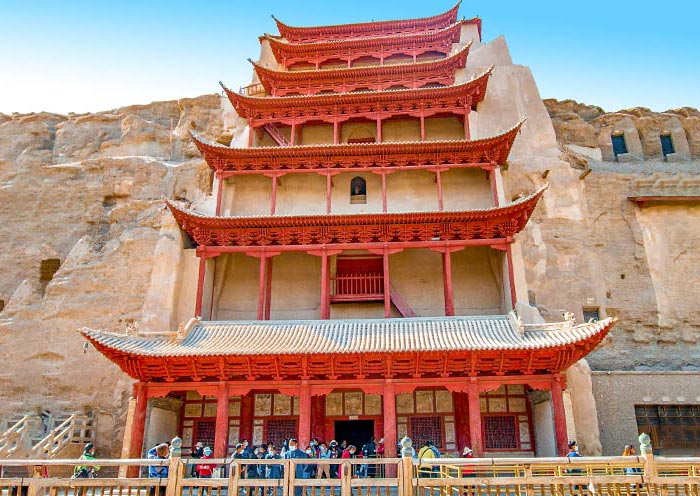
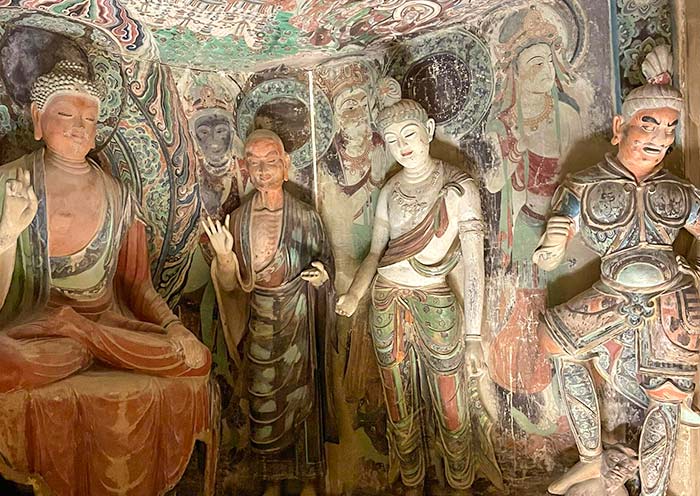
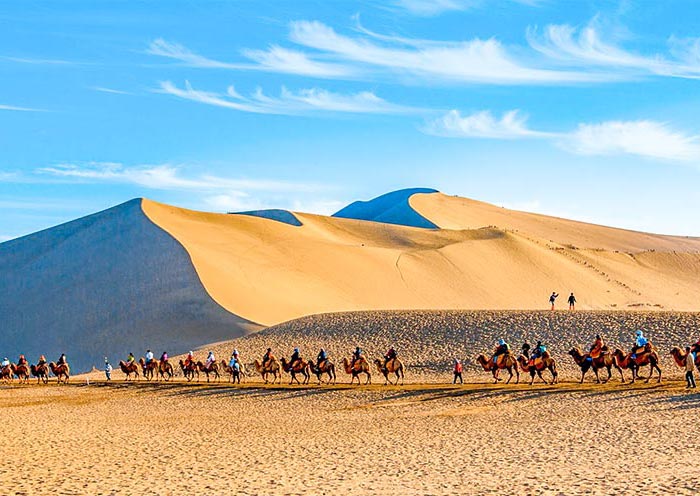
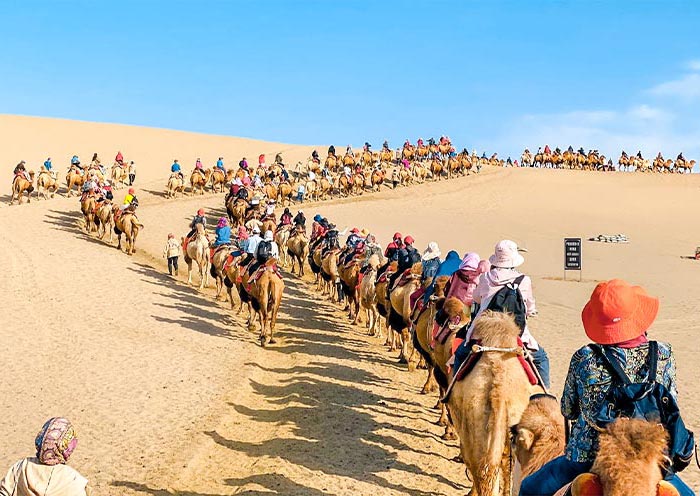
Today, you’ll travel from Dunhuang to Turpan - the heart of Xinjiang’s Silk Road oasis. You can choose between two comfortable options: high-speed train or flight.
If you travel by train, your driver will take you to Liuyuan South Station (about a 2-hour drive) to board the high-speed train to Turpan North Station, a scenic 3.5-hour journey through the Gobi landscape.
If you flight is available on this day, you’ll be escorted to Dunhuang Airport for a 1 hour 15-minute flight to Jiaohe Airport in Turpan.
Upon arrival, your local guide and driver will greet you at the exit and escort you to your hotel for check-in and rest.
Turpan (吐鲁番), located in eastern Xinjiang, lies within the Turpan Depression at 154 meters below sea level - the world’s second-lowest point and China’s hottest place, known as the “Land of Fire.” Despite its harsh desert climate, the ingenious Karez underground irrigation system has turned the area into a green oasis famous for its grapes and vineyards. Once a vital Silk Road hub, Turpan thrived as a crossroads of trade, culture, and religion, leaving behind a legacy of ancient ruins, fortresses, and Buddhist caves that continue to tell its remarkable story.
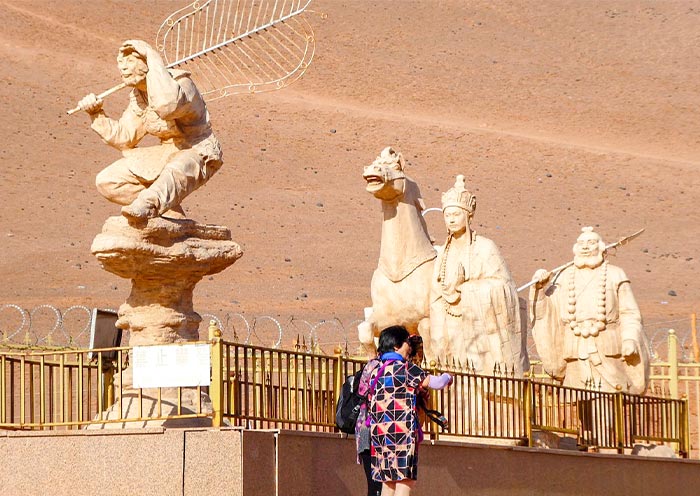
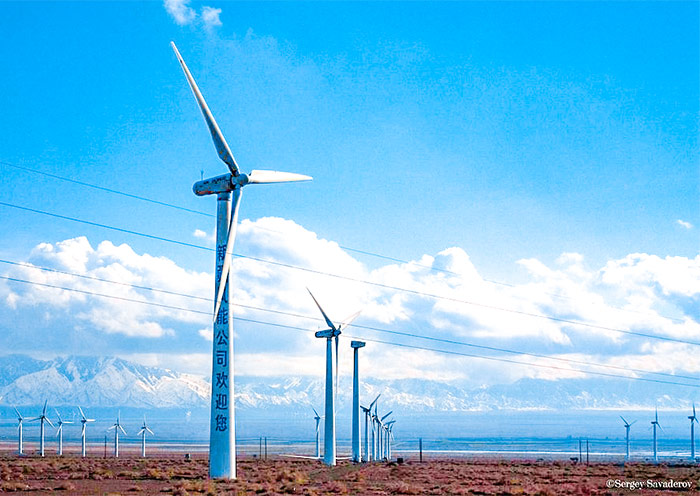
After breakfast, begin your visit to Jiaohe Ancient City (交河故城), one of the best-preserved ruins of ancient cities along the Silk Road and inscribed on the UNESCO World Heritage List as part of the joint application "Silk Roads: the Routes Network of Chang'an-Tianshan Corridor." Jiaohe Ruins offers a profound glimpse into ancient city planning and the historical complexity of the civilizations on the Silk Road.
Nestled between two deep river valleys, Jiaohe, meaning "the confluence of two rivers," is strategically positioned on a large, steep plateau that provides formidable natural defenses. As a key city connecting the Central Plains (中原) and the vast regions of the Western Regions (西域), Jiaohe Ancient City played a vital role in the transportation network of the Silk Road. It witnessed the bustling trade along the Silk Road and the exchange and integration of Eastern and Western cultures.
Unlike many ancient cities, its structures were not built up from the ground but carved down into the existing plateau of loess soil. Walking through the ruins, you can see the remains of government offices, residential houses, Buddhist stupas, and temples. These remnants not only provide important physical evidence for studying the history and culture of the Silk Road but also offer valuable insights into the social, economic, and religious life that shaped this region. Tips: There is no shelter inside the ruin, so be mindful of sun protection.
The History of Jiaohe Ancient City
The Ancient City of Jiaohe witnessed the development of civilization in the Western Region and the Silk Road. Approximately 2,000 years ago, it was established as the capital of the Jushi Kingdom (车师国), one of the 36 kingdoms in the Western Regions (西域三十六国). Following Zhang Qian's pioneering efforts during the Western Han Dynasty to carve a path through the Western Regions, Jiaohe City emerged as a crucial hub on the Silk Road. In 60 BC, the Han Dynasty central government established the Protectorate of the Western Regions (西域都护府) to administer the various states in the region, officially incorporating the Western Regions into the Chinese domain. During the Northern and Southern Dynasties, Jiaohe became a county under the jurisdiction of Gaochang(高昌). The city reached its zenith during the Tang Dynasty with the establishment of the Anxi Protectorate (安西都护府), marking a new era in the governance of the Western Regions. During this period, Jiaohe was a bustling center of international trade and vibrant cultural exchanges among diverse ethnic groups. From the 19th to the 14th century, due to the impact of wars, Jiaohe gradually declined and eventually became a ruin.
Next, head to the Karez System (坎儿井) to learn about the ancient underground irrigation system a few thousand years ago and how this system has benefitted the people along the desert's edge, transforming barren land into a lush oasis. This traditional engineering marvel is considered one of China’s three great ancient engineering projects, alongside the Great Wall and the Grand Canal. It has been recognized in the 2024 World Irrigation Project Heritage list.
The origin of the Karez Irrigation System
Turpan, in Xinjiang, is one of China's most arid regions, with annual rainfall of only 16 millimeters and evaporation exceeding 3,000 millimeters. These extreme conditions have led to severe surface water scarcity. To improve their survival prospects, people ingeniously utilized the natural slope of mountains to channel underground rainwater, glacial melt, and snowmelt from spring and summer to the surface for irrigation. This method greatly reduced water loss through surface evaporation, meeting the water needs of this arid region. It’s often said, "Without the Karez, there would be no Turpan; without the Karez, there would be no civilization in Turpan." The Karez has turned extremely arid basins into green havens, making Turpan a crucial corridor for East-West exchanges along the Silk Road and a place where diverse cultures converge and coexist.
The Karez system is often referred to as the "Underground Great Wall". In Xinjiang, there are over 1,700 karez wells which, if connected, would stretch over 5,000 kilometers, forming a vast underground river network. It is estimated that the Karez system has a history of over 2,000 years. Imagine centuries ago, without modern measuring tools or mechanical assistance, how ancient people located underground water sources, determined the gradient and direction in complete darkness, and connected such lengthy channels. Today, you have the opportunity to step into the Karez and personally unravel the secrets of this most mysterious hydraulic engineering project, experiencing first-hand how ancient innovation works.
Next, continue your exploration at the Emin Minaret (额敏塔), the tallest Islamic minaret in Xinjiang. Also known as Sugong Ta (苏公塔), this remarkable structure was erected in 1778 by the local ruler Suleiman, in tribute to his father, Emin Khoja, whose considerable efforts helped maintain national unity.
It stands 44 meters (144 feet) tall and is made from sun-dried bricks, which give it a distinct, earthy color. The tower's cylindrical body tapers elegantly as it rises, topped by an ornate, pointed dome. Uyghur artisans crafted up to 15 different types of brick patterns, including waves, diamonds, floral clusters, and crosses, which create endlessly looping designs around the tower. Gazing up from beneath the tower, you can fully appreciate the simplicity and grandeur of these designs. The accompanying mosque is an integral part of the complex, which you can visit as well. Emin Minaret serves not only as a religious structure but also as a cultural icon for the Uyghur people, embodying a unique blend of Islamic and Uyghur architectural traditions.
Afterward, you will embark on a scenic 3-hour drive (180 km) from Turpan to Urumqi. Along the way, you’ll pass the striking Salt Lake and the impressive wind power station, the largest in Asia, at the foot of the Tianshan Mountains.
Stay overnight in Urumqi.
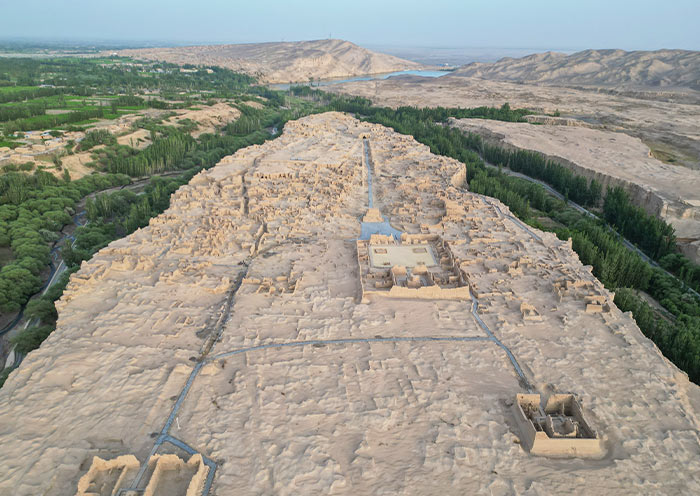
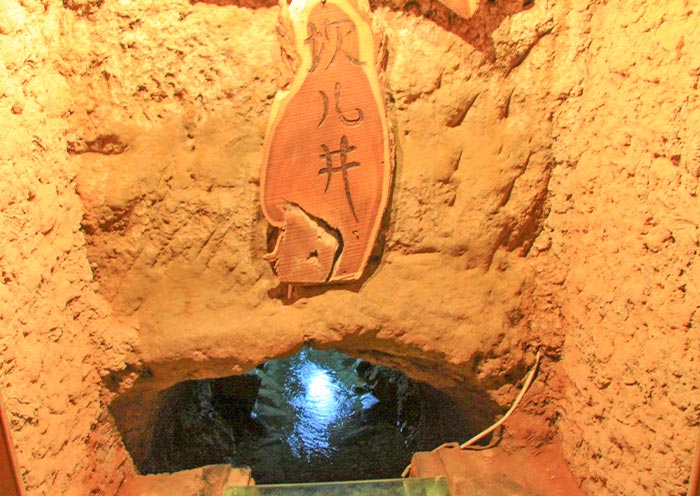
Today, you'll embark on a full-day exploration, from the breathtaking natural beauty of Tianshan Tianchi Lake to the enlightening exhibits at the Xinjiang Regional Museum.
In the morning, you'll be driven approximately 70 kilometers (about 1-1.5 hours) to Heavenly Lake of Tianshan (天山天池), a UNESCO World Heritage Site. Nestled at an elevation of around 1,980 meters (6,500 feet) above sea level, this serene alpine lake is surrounded by lush forests, snow-capped peaks, and breathtaking landscapes. Renowned for its crystal-clear waters, panoramic Bogda mountain views, and connections to ancient myths and legends, Heavenly Lake is a must-see. One such legend involves the Queen Mother of the West (Xi Wangmu), who is said to have hosted a banquet for the Eight Immortals here.
Upon arrival, you'll first take 40-minute sightseeing bus ride through the dramatic mountains. Then, enjoy 10-minute walk to the picturesque lake. Enjoy a leisurely stroll around Heavenly Lake, taking in the fresh mountain air and diverse flora and fauna.
Optional Activities (additional fee required):
- Boat Ride:Cruise across the peaceful waters of the lake, immersing yourself in its beauty and the reflections of the snow-capped mountains.
- Cableway Ride:Take a cableway up to Mayashan for even more stunning views of Bogda Mountain.
After lunch, return to Urumqi and visit the Xinjiang Regional Museum (新疆维吾尔自治区博物馆). This renowned museum showcases theregion's rich history, ethnic cultures, and the ancient Silk Road. Explore extensive collections that include exoticartifacts from the Silk Road, and fascinating displays of traditional ethnic costumes and household items from variouscultures such as Uyghur, Kazakh, and Han. The most unique is the exhibit of ancient mummies, which houses some of theworld’s best-preserved mummies, including the famous “Loulan Beauty 楼兰美女”, one of the 3,800-year-old desert-mummifiedbodies of Indo-European ancestry. Remember to take a look at the 'Five Stars Rise in the East, Benefit China' HanDynasty Brocade Armband (”五星出东方利中国”汉代锦护臂), which is one of the first batches of cultural relics in China that wereprohibited from being exhibited abroad. It is acclaimed as one of the greatest archaeological discoveries of20th-century China. Also, the "Fu Xi and Nu Wa Silk Painting (伏羲女娲图)" illustrates the image of human ancestors fromancient Chinese myths and legends, dating back to the Tang Dynasty. The museum’s immersive exhibits will transport youback in time, allowing you to learn about the fascinating history of the Silk Road and the cultural interactions thathave shaped Xinjiang.
Note: If the Xinjiang Regional Museum is closed on Monday, we will visit the Urumqi Grand Bazaar (新疆国际大巴扎) instead.
After the tour, return to your hotel in Urumqi.
Free Time Ideas:
The Urumqi Grand Bazaar, also known as the Xinjiang International Grand Bazaar, is a vibrant marketplace and a perfect way to spend your free time. Explore the many shops and stalls offering various local products, including traditional Uyghur clothing, carpets, handmade crafts, silk scarves, jewelry, spices, and dried fruits. Be sure to try local favorites such as lamb kebabs, polu (pilaf), naan bread, and laghman (hand-pulled noodles). Additionally, the architecture of the Grand Bazaar itself is worth admiring with its grand minarets, domes, and intricate Islamic-inspired designs.
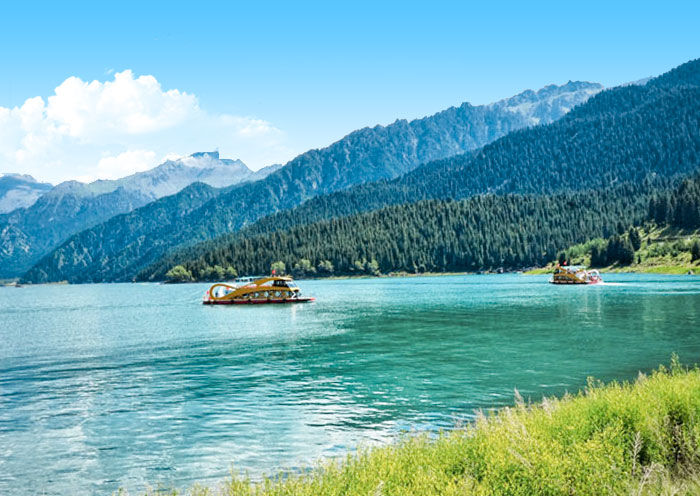
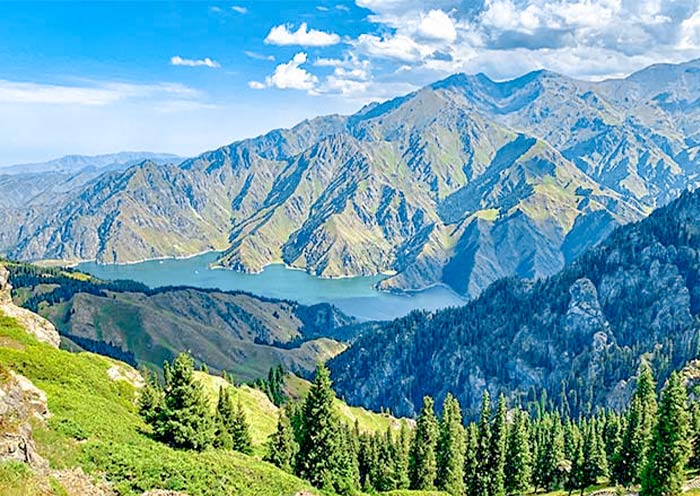
On this day, you will leave Urumqi and head to the ariport for the flight to Tashkent, Uzbekistan. It is about 3 hours’ flight.
Welcome to Tashkent, Uzbekistan’s vibrant capital and largest city! This modern metropolis is the perfect gateway to the country’s Silk Road wonders, seamlessly blending Soviet-era grandeur with contemporary spirit.
Upon landing at Tashkent International Airport, your guide will meet you at the arrival gate, holding a sign with your name. From there, transfer to your downtown hotel, and check in your hotel. (Tip: the airport is located just about 7 km southeast of the city center, a quick and easy transfer.)
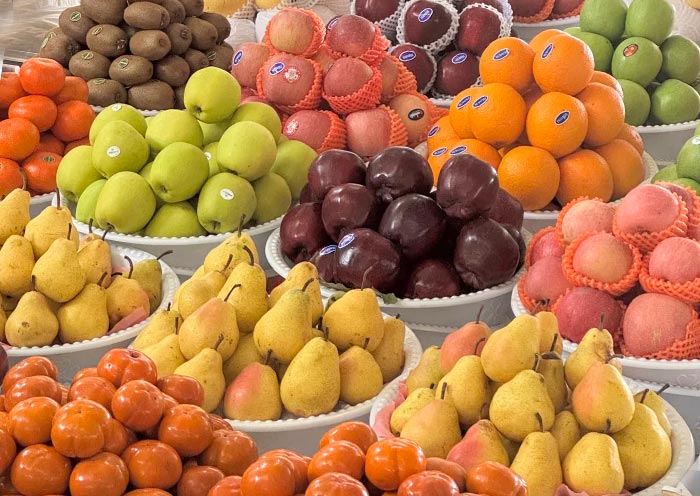
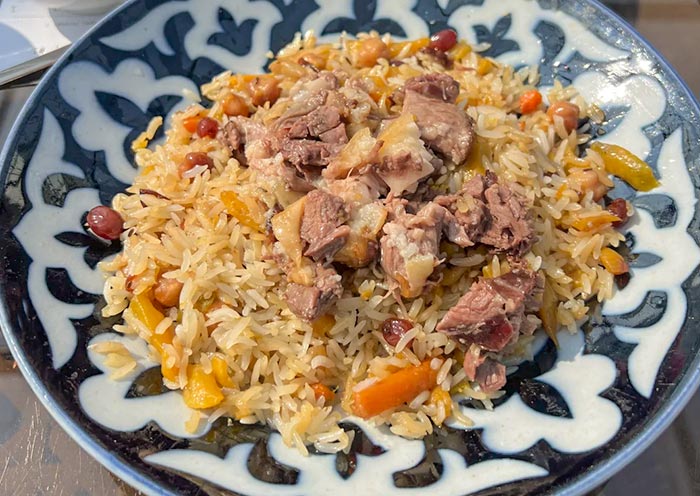
After breakfast, set out for a full-day exploration of Tashkent, Uzbekistan’s vibrant capital and a city where centuries-old tradition meets modern charm.
Begin your day in the Old City at the Khast-Imam Complex, the spiritual heart of Tashkent. This serene ensemble of blue-domed mosques, mausoleums, and madrasahs invites you to step back in time. Here you’ll find the elegant Hazrati Imam Mosque, whose twin 53-meter minarets and gold-leafed domes dominate the square, as well as the Tillya Sheikh Mosque, Barak Khan Madrasah, and the Mausoleum of Abu Bakr Kaffal Shashi, a 10th-century scholar, poet, and locksmith-saint after whom the complex is named. Be sure to visit the Mui Muborak Library, home to the revered 7th-century Osman Qur’an - one of the world’s oldest copies.
After soaking up the complex’s peaceful atmosphere, stroll through Barak Khan Madrasah, now home to artisan workshops and boutiques. Watch local masters create ikat fabrics, woodcarvings, pottery, and jewelry, giving you a chance to bring home a unique handmade souvenir.
Continue your immersion in local culture with a visit to Chorsu Bazaar, Tashkent’s largest and most iconic marketplace. Beneath its turquoise dome, vendors sell colorful spices, dried fruits, fresh bread still warm from the tandoor, and vibrant handicrafts. Sample street food, chat with friendly locals, and experience the daily rhythm of Tashkent life.
Next, explore the State Museum of Applied Arts, where more than 7,000 exhibits showcase Uzbekistan’s finest craftsmanship from the 19th century to today. Admire intricate gold embroidery, suzani textiles, ceramics, jewelry, carpets, and woodcarvings, gaining a deeper appreciation for the country’s artistic traditions.
In the afternoon, descend underground for a ride on the Tashkent Metro - an experience in itself. As the first subway system in Central Asia, it is a living museum of Soviet architecture and Uzbek decorative art. Each station is uniquely designed, from Kosmonavtlar with its cosmonaut-themed mosaics to Paxtakor with cotton motifs.
Emerge at Amir Timur Square, the heart of modern Tashkent. Surrounded by landmarks such as Hotel Uzbekistan, the Palace of International Forums, and the University of Law, the square is anchored by a bronze equestrian statue of Amir Timur, the great Central Asian conqueror and founder of the Timurid Empire. Take time to relax by the fountains, stroll through the green spaces, and - if time allows - visit the Amir Timur Museum (closed Mondays), whose striking dome is depicted on the 1,000-som banknote. Inside, discover fascinating exhibits on Timur’s life and legacy.
After the tour, be escorted to the hotel in Tashkent.
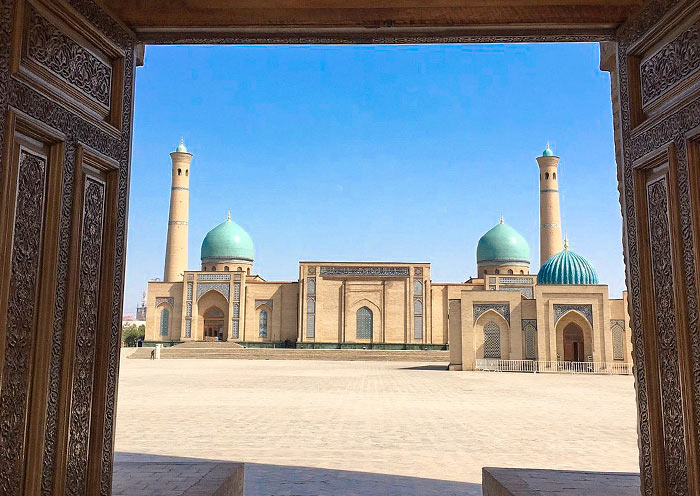
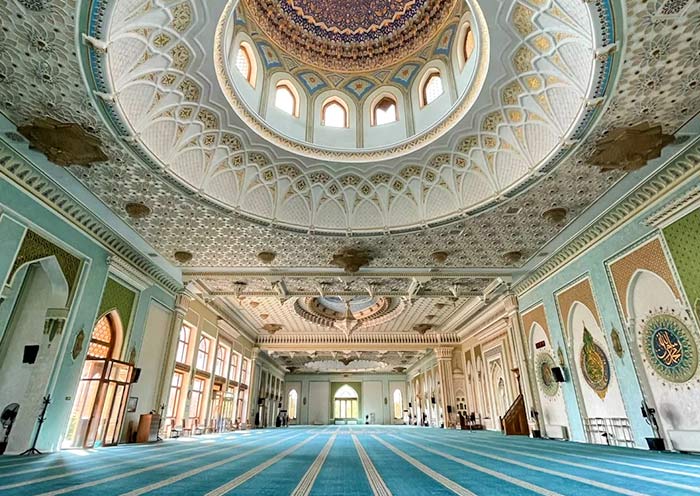
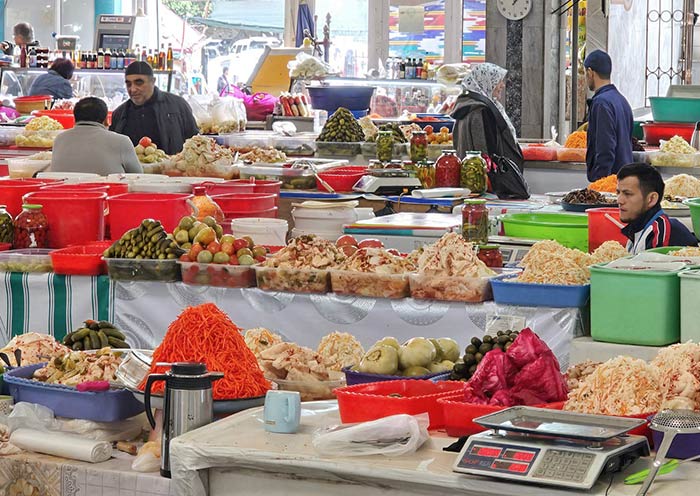
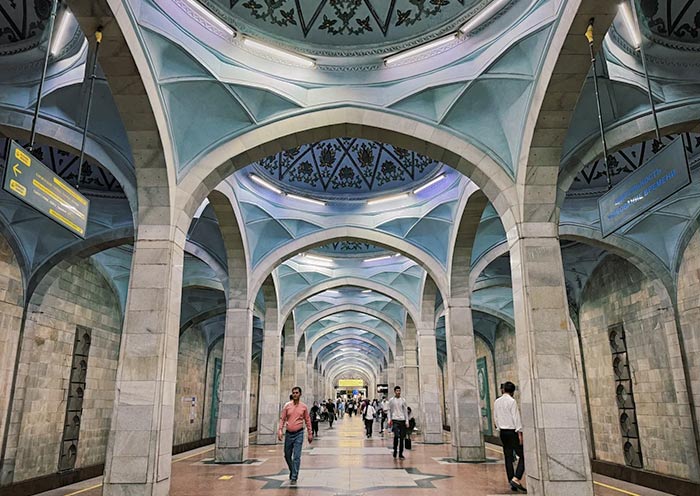
Start your day with a morning flight to Urgench International Airport, followed by a short 36 km transfer to Khiva (World Heritage). Traveling from modern Tashkent, the gateway to the Silk Road, to remote Khiva, feels like stepping through a portal in time. It thrived in the 16th century as a safe hub for Silk Road trade and cultural exchange, blending Persian, Turkic, and Russian influences.
“I would offer a bag of gold merely to catch a glimpse of Khiva" is a well-known Central Asian saying that reflects the city's legendary beauty. Step into Khiva, a living "open-air museum" that functions as a perfect time machine to the medieval era. This reputation is built upon the magnificent Itchan Kala, the inner-walled city that remains a frozen-in-time gem.
As the heart of the Khwarezm Empire (10th-17th centuries), Itchan Kala boasts Central Asia’s only fully intact walled medieval fortress city, famed for its "fully preserved medieval walls" that rise 10 meters high to enclose the entire old town. Compact and charming, the historic core spans just 26 hectares, housing a permanent population of ~2,000 residents. All key sites (palaces, madrasahs, mosques, minarets, mausoleums) cluster within a 1-kilometer radius, making the labyrinth of mud-brick buildings, narrow alleys, and traditional tea houses easily explorable on foot in half a day."
You can enter from Ichan Kala West Gate (Ata Darvaza) to visit the landmark of Khiva - Kalta Minor Minaret (Short Minaret). The unfinished minaret (29 m; stopped at 1855) dazzles with colorful bands. Nearby, the Muhammad Amin Khan Madrasah (largest in Khiva & Central Asia), famed for azure tiles. Sayid Allauddin Mausoleum (Eastern saint and Sufi sheikh; 14th-century) offers quiet reflection. Pakhlavan Makhmud Mausoleum (Khiva’s patron saint/wrestler-poet), Khiva’s holiest site, boasts turquoise domes. Climb the Islam Khoja Minaret (57 m tall; self-pay) for panoramic views. The Juma Mosque (Friday Mosque) impresses with its “forest” of 218 ancient wooden columns. Allakuli Khan Madrasah features intricate tilework. Tosh Hovli Palace (Stone Palace) showcases harem quarters and mirrored halls. Mohammed Rakhim Khan Madrasa blends history and architecture. End at Kuhna Ark (Old Fortress), the 17th-century fortress with sweeping views of Khiva. You can visit khans’ harem, mint, stables, arsenal, barracks, mosque and jail to get a peek at the life of the khans.
You can also walk along the Itchan Kala Walls (self-pay), which provides incredible panoramic views of the entire old city & is a good spot for sunset viewing. (PS: You can see Itchan Kala on the 100,000 Uzbekistani som banknote.)
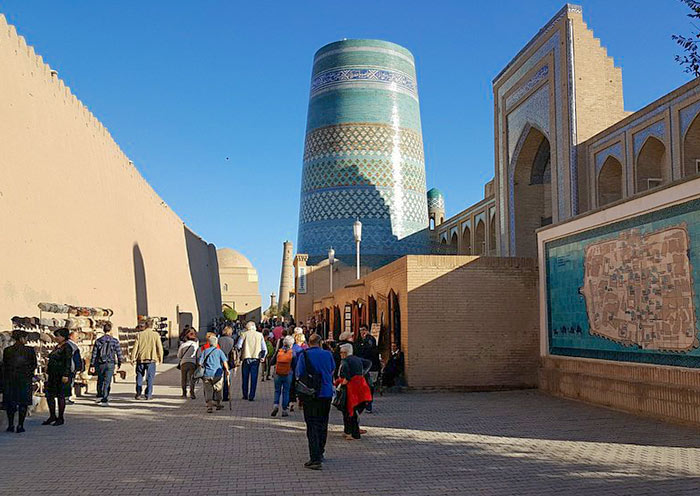
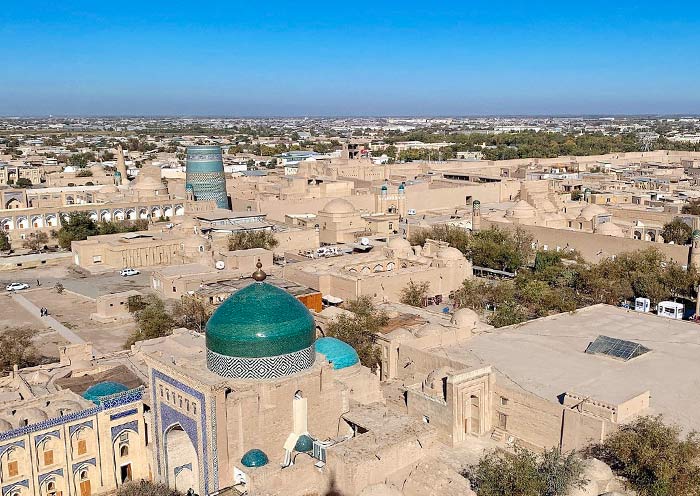
Today, you can enjoy your time in Itchan Kala before departing Khiva. The journey from Khiva to Bukhara (460 km) offers a spectacular insight into the vast, timeless landscapes of Uzbekistan. (Note: Please let us know if you would prefer to take the afternoon train from Urgench to Bukhara, a journey of approximately 6 hours, arriving in Bukhara at night.)
The route cuts straight through the vast, sun-scorched Kyzylkum Desert (Red Sand Desert), where rolling red-sand dunes and sparse saxaul vegetation stretch to the horizon. As one of the largest and most fascinating deserts in Central Asia, the Kysylkum Desert covers an area of around 300,000 square kilometers across parts of Uzbekistan, Kazakhstan, and Turkmenistan. The desert’s dunes can reach a height of up to 200 m, forming breathtaking landscapes. Try your luck to spot some of the local desert inhabitants, such as Gazelles, black rams, foxes, lizards, jerboas, hares, ground squirrels, eagles, owls, etc.
Near Khiva, the route briefly parallels the Amu Darya River, Central Asia’s historic lifeline that flows through Tajikistan, Turkmenistan, Uzbekistan, and Afghanistan. This offers views of its silver-blue waters before veering south. As the desert stretches ahead, you may witness nomadic yurts, camel caravans, and seasonal oases. The road cuts through windswept steppes, revealing ancient caravanserais and distant mountain silhouettes. Sunset paints the desert in amber hues, while Bukhara’s minarets emerge on the horizon.
In ancient times, the Great Silk Road passed through the Kyzylkum Desert. Thanks to the mighty Amu Darya River, cities like Khiva, Bukhara, and Samarkand flourished.
Arrive in Bukhara for an overnight stay.
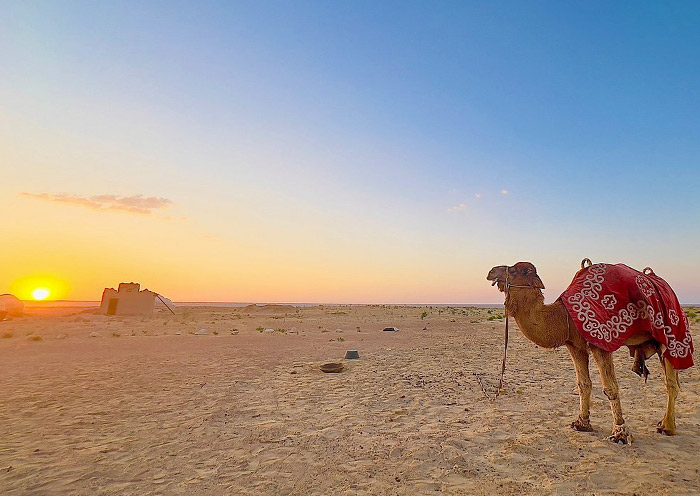
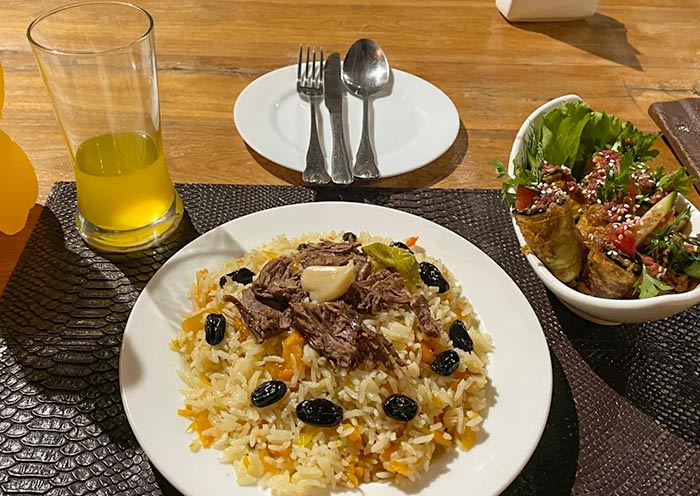
Take a morning train to explore Bukhara, a UNESCO site. Referred to as the "Second Mecca", Bukhara is famous as a 2,500-year-old Silk Road Hub (Samanids to Timurids) and a center for Islamic scholarship. It is also the legendary home of Afandi & is an ancient city tied with the One Thousand and One Nights.
Bukhara is a medium-sized city & nearly all monuments are within walking distance. From Chor Minor to Lyabi Khause Square, Magoki Attori Mosque, Trading Domes, Kalyan Minaret & Ark Fortress, it is about 6 km city walk. Ready to get lost in its living history, friendly locals, and vibrant bazaars!
When you arrive in Bukhara, you'll transfer to Chor Minor Madrasah, the Lonely Planet Central Asia cover star. "Chor Minor" means "four minarets" in Persian. The four minarets were built in 1807 by the wealthy Turkmen merchant Khalif Niyazkul for his four daughters. Each of the towers has a unique decoration. Some people believe that the four different designs reflect the world’s four religions. You may see clear images of Buddhist prayer wheels, Christian crosses, Zoroastrian motifs, or Islamic motifs. It is said that the surviving four-tower structure is part of the gateway from a once-existing madrasah complex.
Next, head to the Lyabi Hauz Ensemble (Lyabi Khause Square), Bukhara’s vibrant 17th-century heart. It was a trade square built around a pool dug in 1620 and shaded by ancient mulberry trees. “Lyabi-Hauz” in Persian means "by the pool." The ensemble’s large artificial pool (42 m long, 36 m wide, and 5 m deep) is surrounded on three sides by three majestic buildings: the Nadir Divan-Beghi Madrasah (built in 1622; famous for two birds carrying deer toward a "man-in-the-sun" mosaic motif; inspired by Sher-Dor Madrasa’s “Lion” mosaic motif in Samarkand Registan), the Nadir Divan-Beghi Khanaka (a Sufi hospice & monastery, also built in 1622), and the Kukeldash Madrasah (built in 1568). In ancient Bukhara, there were more than 80 such pools, which supplied the city with water. However, they were notorious for spreading disease and were mostly filled in during the 1920s and 1930s.
Built by Nadir Divan-begi (Grand Vizier/prime minister), Lyabi Hauz was once a bustling Silk Road trade hub. It is now alive with cafes and local life. People gather to enjoy tea, watch local craftsmen, and bask in the ambiance of Bukhara’s Silk Road legacy. Don't miss the charming statue of Khodja Nasreddin (Afandi), the wise fool of Sufi legend, riding his mischievous mule. Afandi is a beloved character in the folklore of the entire Muslim world.
You should not miss the Magoki Attori Mosque, Bukhara’s oldest surviving mosque (9th-10th c.). Magok means "recessed," a fitting name since the mosque is located 4.5 meters underground. Marvel at its ancient brickwork, intricate terracotta tiles, and its remarkable survival as a pre-Mongol relic. Today, it houses a carpet museum (self-pay for museum ticket).
After that, continue exploring Trading Domes, the iconic image of Bukhara. They are located on a central pedestrian route in the heart of Bukhara, from the Lyabi Hauz to the Po-i-Kalyan Complex. In the Middle Ages, Bukhara was a major hub on the Silk Road, leading to the proliferation of marketplaces and shops. Today, four main trading domes remain: a cluster of 16th-century domed bazaars (Toki-Zargaron, Toki-Sarrofon, Telpak-Furushon & Tim Abdullah Khan) that once thrived as hubs for jewelry, currency exchange, hats & carpets. Nowadays, you can see stalls selling traditional crafts, textiles, and souvenirs. Enjoy a glimpse into Bukhara’s mercantile past.
Then, you will reach Po-i-Kalyan Complex, the visual high point of the city’s skyline. At Poi Kalon Square, you will see three majestic structures built between the 12th and 16th centuries: the Kalyan Minaret, Kalyan Mosque & Mir-i Arab Madrasah. This breathtaking arrangement of minaret, mosque, and madrasa forms the spiritual and architectural heart of the old city, a perfect example of harmonious design.
The iconic Kalyan Minaret, which once guided Silk Road caravans, was built in 1127. Standing 47 meters tall, it earned the title "Tower of Death" due to ancient legends. During the siege of Bukhara in 1220, Genghis Khan was so mesmerized by this minaret that he spared it from destruction.
The Kalon Mosque (Great Mosque) is a vast hypostyle with 288 domes, capable of holding 10,000 worshippers. The Mir-i-Arab Madrasa is a top Islamic school with stunning turquoise domes and intricate tilework. Constructed with the profits from the sale of 3,000 Persian slaves, the madrasa combines Timurid architecture with active scholarship. Together, these buildings embody Silk Road grandeur—making the complex ideal for photos, history, and cultural immersion.
After that, head to explore the Ark of Bukhara (Ark Fortress), whose image was printed on Uzbekistan’s 2,000-som banknote. It is Bukhara’s ancient fortress, built the 5th c. AD, and rebuilt in the 16th–17th c. For centuries, it served as a royal town-within-a-town for Bukhara’s emirs. Its 11-meter-thick walls enclose museums, the 17th-century Coronation Mosque, a throne room, and prison cells. Outside, in front of the fortress, is medieval Bukhara’s main square, the Registan Square, a favourite venue for executions, including those of the British officers Stoddart and Conolly. Once a symbol of power, it now displays royal artifacts, weapons, and manuscripts. You can explore its labyrinthine chambers, climb the battlements for panoramic views of Bukhara, and learn about Bukhara’s medieval governance.
Located directly opposite the Ark of Bukhara, the Bolo Hauz Mosque (Mosque of the Forty Columns) is a stunning architectural gem. It is a royal mosque built in 1712, famed for its 20 intricately carved wooden pillars and their reflection in the adjacent "Forty Pillars" pond. Famous for its beautifully carved, brightly painted wooden columns and ornate ceiling, it once served as the emir’s Friday mosque. It is a peaceful spot to admire classic Uzbek artistry.
Free Time Idea:
Enjoy a sunset at the Ark of Bukhara. Climb to the top of its facade for a commanding panoramic view of Po-i-Kalyan Complex & the city.
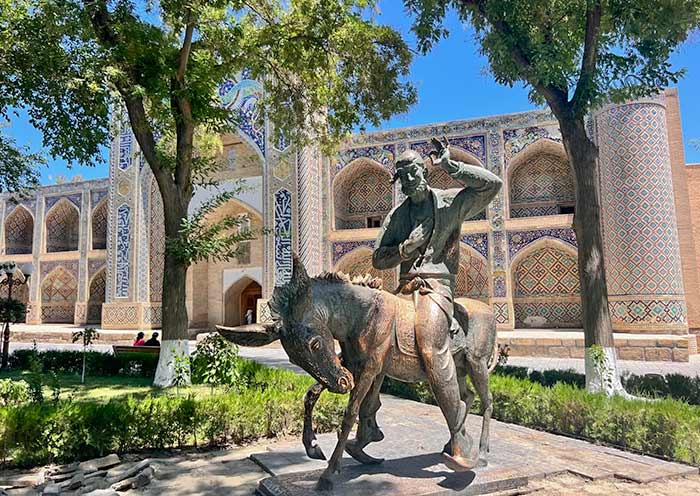
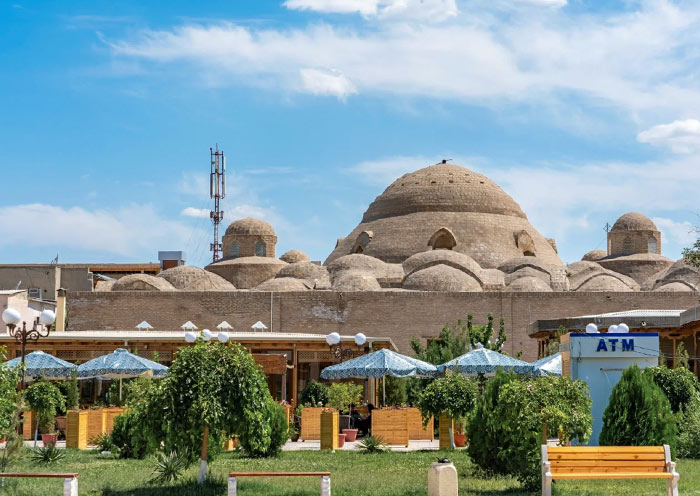
After breakfast, set off from Bukhara toward Samarkand, with a stop in Shakhrisabz - the birthplace of the great conqueror Amir Timur (Tamerlane).
The journey from Bukhara to Shakhrisabz (about 264 km, 4-5 hours) takes you through flat desert landscapes before giving way to rolling hills dotted with lush green fields and orchards.
Upon arrival in Shakhrisabz, explore the Ruins of Ak-Saray Palace, Timur’s grand summer residence. Although only fragments of the monumental gateway remain, its scale is awe-inspiring - its soaring arch once stood over 40 meters high, richly decorated with blue-glazed tiles that hint at its former glory.
Continue to the Dorut Tilovat Complex, a serene ensemble of religious buildings where Timur’s spiritual mentor, Sheikh Shamsiddin Kulol, is buried. Admire the intricately tiled Kok Gumbaz Mosque, known as the “Blue Dome,” built by Timur’s grandson Ulugh Beg.
Then, visit the Dorus Saodat Complex, Timur’s intended dynastic mausoleum. Walk through its tranquil courtyards and see the crypt believed to have been prepared for Timur himself, a place of great historical significance.
After your visit, continue the scenic drive to Samarkand (92 km, about 1.5-2 hours), arriving in the late afternoon or evening. Check in and enjoy a good stay in this legendary Silk Road city.
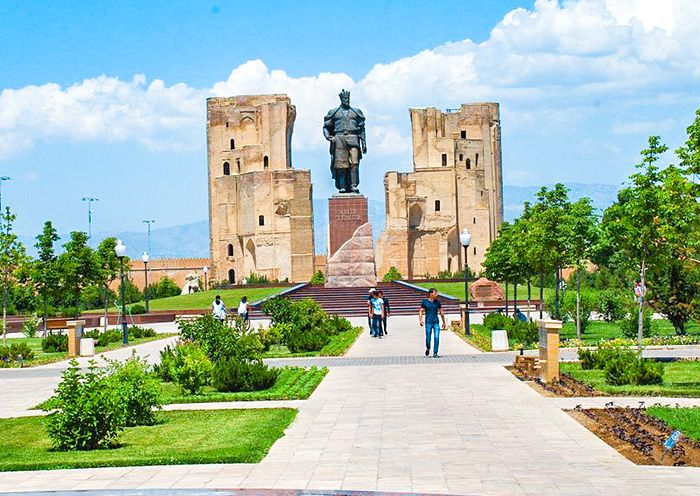
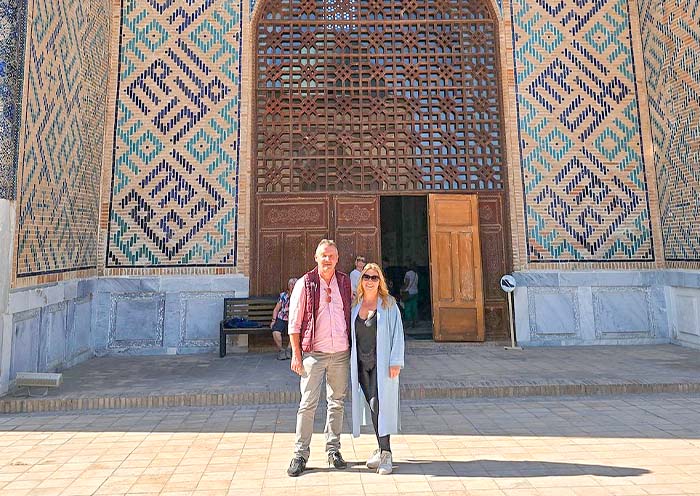
Enjoy your time in Samarkand (World Heritage Site), the capital of the Timurid Empire (14th–15th centuries) & Uzbekistan’s Second-largest City. From Gur Emir Mausoleum (tomb of Timur) to Registan Square (Central Asia’s most famous), Bibi Khanim Mosque (commemorate Timur's wife), Shahi Zinda Necropolis (an open-air art gallery), and Siyab Bazaar (for plov & bread), you will find that its atmosphere is centered around memorial architecture of breathtaking scale & beauty, reflecting the glory and power of the Timurid Dynasty.
Start with a visit to Gur-e Amir Mausoleum of the Mongol Conqueror Amir Timur. Completed in 1404, it was originally intended to be the tomb of Timur’s grandson, but after Timur’s death in 1405, he was interred there as well, along with other members of his family. The mausoleum dazzles with its majestic azure ribbed dome - a prototype for later Mughal architecture, including India’s Taj Mahal. Inside, marvel at the lavish gold-leaf interior, intricate jade tombstones, and ornate calligraphy adorning the walls.
You can look for the inscribed jade plaque marking Timur’s grave - a sacred site shrouded in legend and power. Legend has it that there was a warning against opening the grave, stating, “Whosoever disturbs my tomb will unleash an invader more terrible than I”. However, Soviet archeologists did so on June 19, 1941, and a few days later, Nazi Germany attacked the USSR. When they reburied the remains in 1942, the victorious battle of Stalingrad began. The Soviet anthropologists confirmed Timur’s height (172 cm) and lameness, and the fact that Timur's grandson, Ulugh Beg, was assassinated.
The complex comprised a madrasah & a khanaka (prince’s residence), both facing the rectangular courtyard, as well as four minarets at the courtyard corners and an entrance portal. Now only the foundations of the madrasah and khanaka, the entrance portal, and a part of one of four minarets remains.
Next, visit Registan Square, a must for experiencing the grandeur of Samarkand & the heart of the Silk Road. The word “Registan” means “Sandy Place” in Tajik. Many centuries ago, the area of this square was all in sand. In ancient times, the square served as a meeting place for the governing people and the residents to publicly announce the khans' decrees, to gather the army, to perform executions of bandits, or to celebrate folk festivals.
Located in the heart of Samarkand, this square is also known for the three medieval schools: Ulugh Beg Madrasa (built in 1420; celestial mosaics), Tilya-kori Madrasa (built in 1660; gold-leafed dome; cover photo of the Lonely Planet Book, The Silk Road), and Sher-Dor Madrasa (built in 1619; lion mosaics on Uzbekistan’s 200-som banknote).
Built by Ulugh Beg, Timur's grandson & a scientist on the throne, the Ulugh Beg Madrasa offered not only Islamic education but also astronomy, geometry, philosophy, and the natural sciences. The Sher-Dor Madrasa is famous for the “Lion” mosaic motif on the front of the building. Sher-Dor means “possessing lions”. The Lion mosaic is unique to medieval Islamic historic buildings, since depicting animals and people is against sharia.
By day, admire intricate tilework and soak in the grandeur of Registan Square; by night, be captivated by magical light shows that bring the madrasahs to life. A blend of history, art, and spectacle, it’s a journey through the Silk Road’s golden age. (PS: You can see Registan Square on the 50 Uzbekistani som banknote.)
After that, move to explore Bibi Khanim Mosque (built in 1404), one of the most ambitious architectural projects of the Timurid period. Legend says the mosque was built by the Timur's favorite wife, Bibi-Khanym, in honor of his return from India. The architect fell madly in love with her and refused to finish the job unless he could give her a kiss. The smooch left a mark and Timur, on seeing it, executed the architect and decreed that women should henceforth wear veils. The interiors of the mosque contain gilding, imitating local brocade embroideries.
Right next to Bibi Khanim Mosque, Siyab Bazaar is a sensory delight. This bustling market is a perfect place to experience local life, find fresh fruits, nuts, spices, and famous Samarkand bread.
At last, time to enjoy a walk in Shahi Zinda Necropolis, a captivating "avenue of mausoleums" and an open-air art gallery. It is a 11th-15th c. "Living King" necropolis along a hillside path. Admire Timurid-era blue-tile masterpieces, including tombs of Timur’s family (women) members and high-ranking officials. Legend of Prophet Muhammad’s cousin’s tomb adds mystique. In recent years, Shah-i-Zinda has become not only a pilgrimite but also a favorite destination for photography due to its beauty.
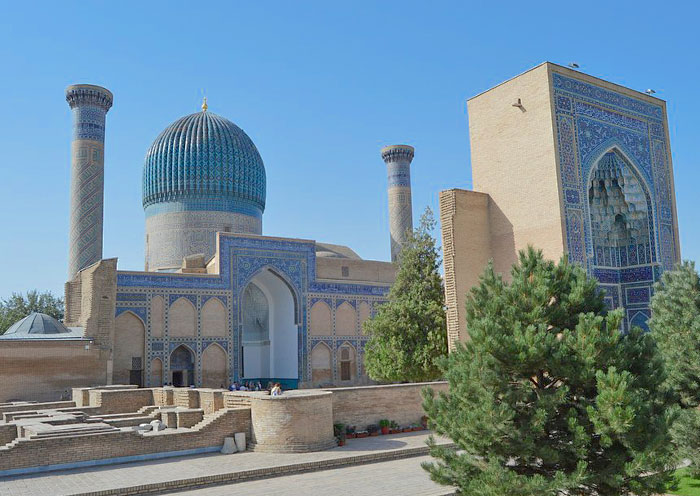
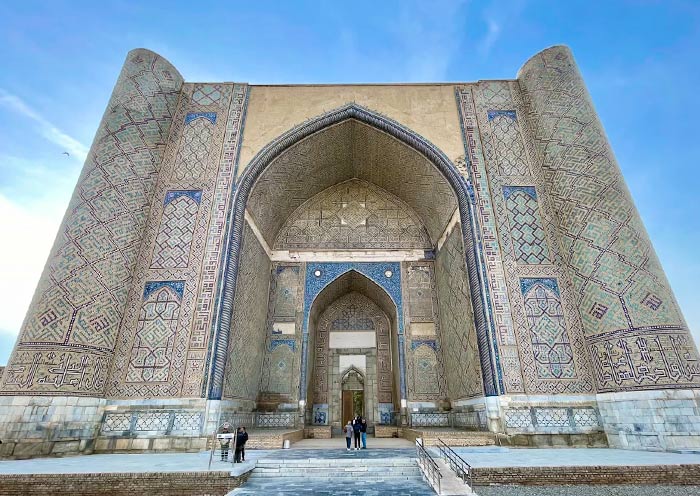
In the morning, explore more about Samarkand, the Silk Road gem. With a visit to the Ulugh Beg Observatory, Tomb of Sait Daniel, and Afrosiab Museum, you may see why it was the center of history, culture, and scientific contributions in the past. Then, head back to Tashkent by train.
The Ulugh Beg Observatory is a must-visit for history and astronomy enthusiasts. Built in the 1420s by the renowned Astronomer King Ulugh Beg (grandson of the emperor Timur), it was one of the most advanced observatories of its time. Destroyed in 1449 and rediscovered in 1908, the ruins reveal medieval Samarkand’s intellectual prowess. You should not miss the impressive sextant (11m long), used to calculate celestial positions with incredible accuracy. The on-site museum offers fascinating insights into Ulugh Beg’s contributions to science. Perched on a hill, the observatory combines breathtaking views of Samarkand with the legacy of a visionary astronomer.
Next, visit the Khodja Doniyor Mausoleum (Tomb of Sait Daniel), a sacred site revered by Muslims, Jews, and Christians alike. It houses the tomb of Prophet Daniel (under five domes), which stretches an astonishing 18 meters long due to a legend of the saint's remains growing over time. Timur brought Daniel’s relics here in the 15th century, creating a pilgrimage hub. This site, located on the banks of the Siab River, also features a sacred spring with healing properties, making it a peaceful and powerful place to reflect and witness the confluence of different faiths. It is a great spot to undestand Samarkand – the crossroads of cultures.
Before transferring to train station for Tashkent, it’s a great idea to conclude your Samarkand tour with a visit to the Afrosiab Museum. This museum, built atop Samarkand’s 2,500-year-old ruins, unveils the city’s ancient soul. Its crown jewel is the 7th-century Sogdian frescoes, notably the "Hall of Ambassadors" mural, depicting King Varkhuman receiving envoys from China, Persia, and beyond—a testament to Silk Road diplomacy. Artifacts like pottery, coins, and ossuaries trace eras from the Achaemenid to Timurid periods, while a scale model reconstructs the pre-Mongol metropolis. A must for history lovers to walk through a lost golden age.
Take a train ride to Tashkent for overnight.
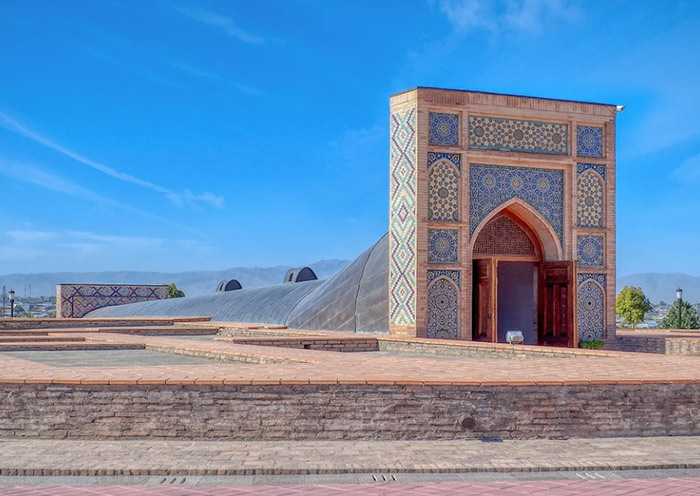
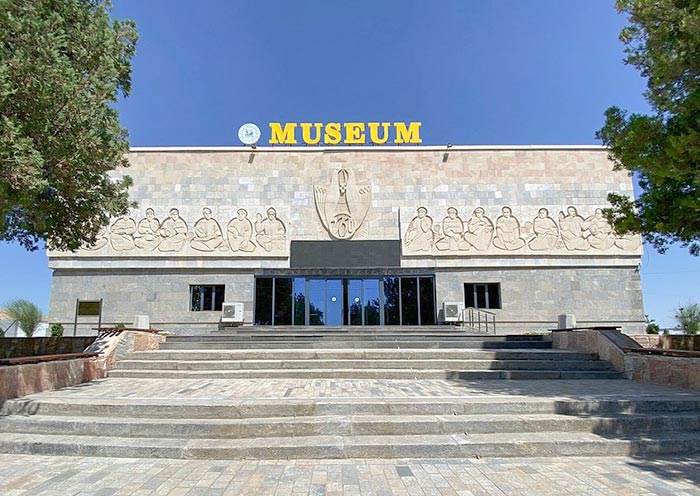
After breakfast, it is time to end your China & Uzbekistan Tour. Your driver will ensure a smooth transfer to Tashkent International Airport for your departure flight.
Trip Extension: If you'd like to extend your adventures in Central Asia, consider exploring other notable regions like Kyrgyzstan, Kazakhstan, Tajikistan, and Turkmenistan, etc. Feel free to contact us to customize your extended itinerary.
Thank you for choosing Asia Odyssey Travel for your tour of Asia. We are dedicated to enhancing your travel experiences and look forward to welcoming you on your next adventure in Asia. Have a safe journey home!
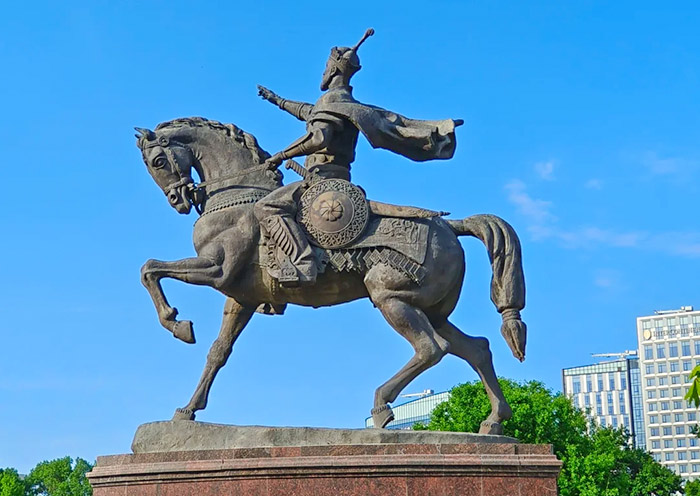
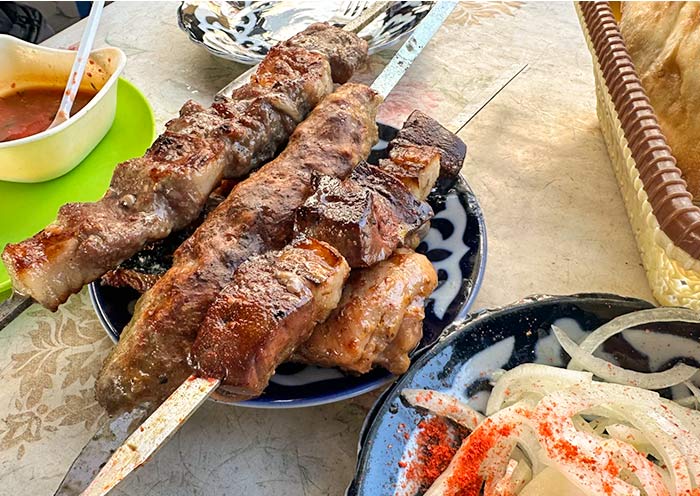
Price: What’s Included & What’s Excluded
What's Included:
What's Excluded:
Central Asia Trip Notes & Booking Tips
| Country | Highlights | Must-Do Experiences |
|---|---|---|
| Kazakhstan | Endless steppe, futuristic cities, striking natural wonders | Explore Almaty’s lively streets, marvel at Charyn Canyon, ride cable cars to mountain viewpoints, and learn about nomadic horse culture |
| Kyrgyzstan | Mountain peaks, alpine lakes, nomadic spirit | Stay in a yurt at Issyk-Kul Lake, visit Burana Tower, hike alpine gorges, and watch eagle hunting demonstrations |
| Uzbekistan | Silk Road jewels, turquoise domes, vibrant bazaars | Wander Registan Square in Samarkand, explore Bukhara’s old town, admire mosaics in Shakhrisabz, shop for silk, spices, and carpets |
| Tajikistan | Rugged mountains, hidden valleys, Sogdian history | Discover Penjikent’s ruins, trek to the Seven Lakes, and meet locals in remote mountain villages |
| Turkmenistan | Marble cities, desert mysteries, Silk Road ruins | Camp by the fiery Darvaza Gas Crater, explore Ancient Merv, and see Ashgabat’s white-marble monuments |
- Spring (April June): Mild weather, blooming valleys, fewer crowds
(1) Perfect for sightseeing in Uzbekistan’s Silk Road cities (Samarkand, Bukhara, Khiva) before the summer heat. (2) Kyrgyzstan’s and Kazakhstan’s mountains are lush and green, great for gentle hikes. (3) Desert areas in Turkmenistan are comfortable for visiting Darvaza Gas Crater and Merv.
- Autumn (September October) - Most Recommended Season: Pleasant temperatures, colorful landscapes
(1) Ideal time for a grand tour of all 5 Stans. (2) Crisp, sunny days make exploring cities and mountain regions easy. (3) Harvest season - fresh fruits, bazaars full of melons, grapes, pomegranates. (4) Issyk-Kul Lake and alpine gorges in Kyrgyzstan are at their most photogenic.
- Summer (July August): Hot in deserts & Silk Road cities (up to 40°C), but: great for high-altitude trekking in Kyrgyzstan and Tajikistan (Pamir Mountains, Seven Lakes).
For most western / developed-country travelers, Kazakhstan, Kyrgyzstan, Uzbekistan, and Tajikistan are fairly easy to enter (visa-free or e-visa) if you plan properly.
Turkmenistan remains the most challenging: must plan ahead, may need a LOI, possibly limit to tour operator itineraries.
Always check entry point regulations (airport vs land border), as some visas / e-visas / visa-on-arrival are only valid through certain border crossings.
Double-check the duration you're allowed (30, 45, 60, 90 days) - depends heavily on your passport country.
| Theme | Highlights | Where |
|---|---|---|
| Silk Road Cultures | Wander historic Silk Road cities with turquoise domes and caravanserais | Uzbekistan: Samarkand, Bukhara, Khiva |
| Explore an ancient Sogdian city and its 7thcentury frescoes | Tajikistan: Penjikent | |
| Contrast Ashgabat’s modern whitemarble skyline with the ruins of ancient Merv | Turkmenistan: Ashgabat, Merv | |
| Meet artisans weaving carpets, baking traditional bread, crafting felt yurts - living nomadic traditions | Across Central Asia (community workshops, markets, yurt makers) | |
| Nature Landscapes | Marvel at the Darvaza Gas Crater glowing in the Karakum Desert | Turkmenistan: Darvaza, Karakum Desert |
| Relax by IssykKul, the “Pearl of Kyrgyzstan,” ringed by snowcapped peaks | Kyrgyzstan: IssykKul Lake | |
| Hike to Tajikistan’s Seven Lakes or explore the “little brother” to the Grand Canyon | Tajikistan: Seven Lakes; Kazakhstan: Charyn Canyon | |
| Experience nomadic life in a yurt camp, ride horses in alpine valleys, stargaze on the steppe | Kyrgyzstan, Kazakhstan (yurt camps, alpine pastures) |
- Darvaza Gas Crater camping with desert stargazing
- In-depth Silk Road exploration of Samarkand’s old city
- Tajikistan’s Seven Lakes hike with a lakeside picnic
- Kyrgyz falconry show and hands-on yurt-making experience
- Charyn Canyon hike plus Almaty cable car to a skyline night view
- Tajik home visit with demonstrations of traditional handicrafts
Our tour is designed to provide a comprehensive experience without feeling overly rushed. We balance city tours with travel days to ensure you get enough rest. While some days involve long drives between destinations, we plan strategic stops for sightseeing and breaks. You'll have time to explore the major sites in each city and enjoy the journey between them. The pace varies by region: cities like Samarkand are fast-paced, while the mountain regions of Tajikistan and Kyrgyzstan offer a slower, more relaxed tempo.
Here’s what to expect at the most commonly used checkpoints:
| Border Crossing | Connects | Opening Hours | Crossing Time | Crossing Type | Notes for Travelers |
|---|---|---|---|---|---|
| Oybek | Tashkent (Uzbekistan) ⇆ Khujand (Tajikistan) | Daily, usually 08:00–18:00 | ~30–60 min (may be longer on weekends/holidays) | Pedestrian & vehicle | One of the busiest crossings; be ready for lines. Good road conditions on both sides. |
| Jartepa | Samarkand (Uzbekistan) ⇆ Penjikent (Tajikistan) | Daily, 08:00–18:00 | ~20–40 min | Pedestrian & vehicle | Most convenient for travelers; short transfer, border staff generally friendly. |
| Shavat | Khiva/Urgench (Uzbekistan) ⇆ Dashoguz (Turkmenistan) | Daily, 09:00–18:00 | ~45–90 min | Pedestrian only (vehicles drop/pick up travelers at both sides) | Requires Turkmen visa in advance or pre-arranged LOI. Can be busy in mornings. |
| Farap | Bukhara (Uzbekistan) ⇆ Turkmenabat (Turkmenistan/Mary route) | Daily, 08:00–18:00 | ~1–2 hrs | Pedestrian & vehicle | Key crossing for travelers heading to Merv; customs can take longer, be patient. |
| Korday | Bishkek (Kyrgyzstan) ⇆ Almaty (Kazakhstan) | Open 24 hrs | ~30–60 min (rush hours longer) | Pedestrian & vehicle | Major highway crossing, usually efficient; popular with locals and travelers. |
Traveler Tips:
- Timing Matters: Arrive early in the morning to avoid queues, especially at Shavat & Farap.
- Paperwork Ready: Keep passports, visas (or e-visa printouts), and customs forms handy.
- Walking vs. Vehicle:At some borders (Shavat, Oybek), you may need to walk across the neutral zone (few hundred meters).
- Seasonal Considerations: Summer is busier due to local travel; winter may bring delays from weather.
- Patience & Flexibility: Border procedures are generally friendly but not always fast - use this time to experience the real pace of Central Asia.
Hotels & Camping Experiences in Central Asia
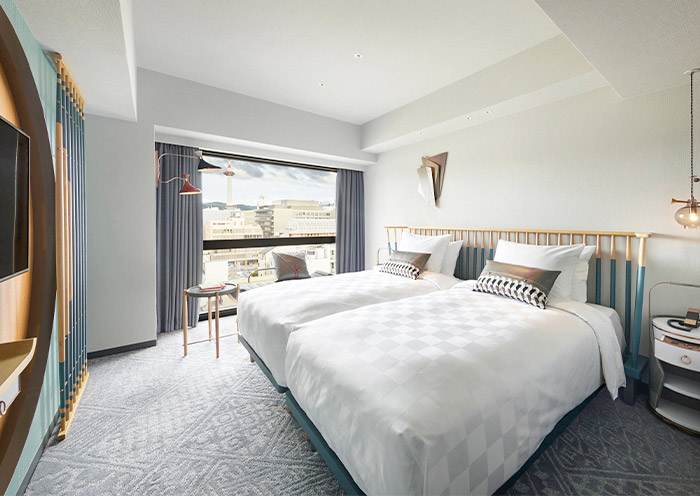

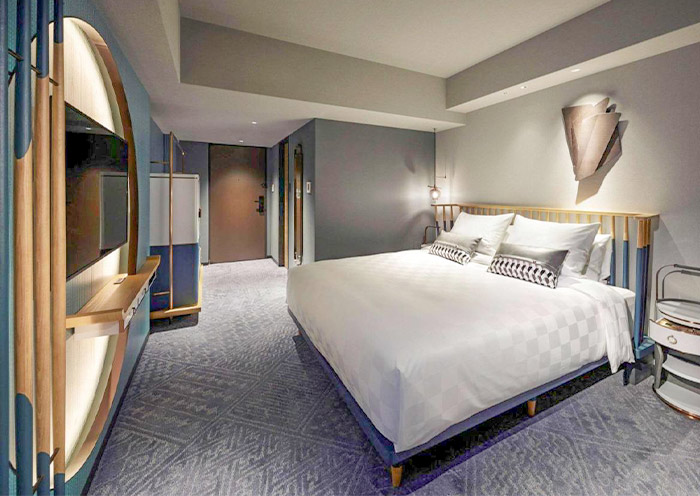
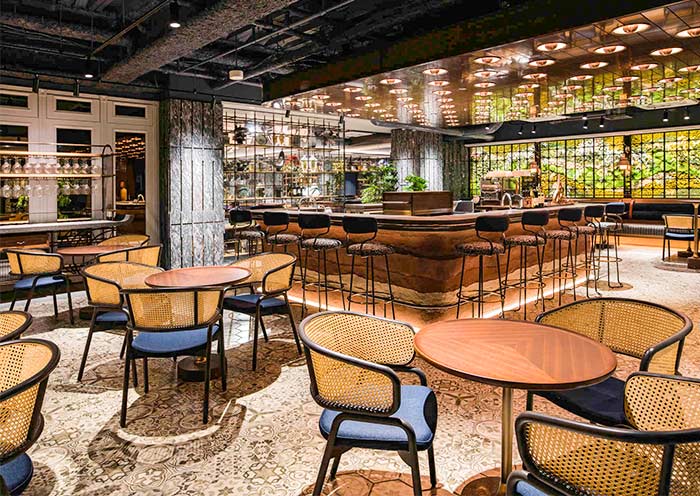
We carefully select accommodations across the five “Stans” to ensure both comfort and authenticity.
In Cities:
You will stay in well-located hotels (3-5 stars, with 4 stars recommended) - a mix of international chains and charming boutique hotels. All are clean, comfortable, non-smoking, and offer easy access to lively bazaars, shopping streets, and major attractions. Free Wi-Fi is available in most properties.
In Villages & Countryside:
Around the Seven Lakes, Pamir, and Issyk-Kul areas, accommodation is mainly in cozy family guesthouses, mountain lodges, or traditional yurt camps. Facilities are simple but authentic, letting you experience the local way of life. Yurt camps in Kyrgyzstan and Kazakhstan are usually shared or semi-private, with communal or partially private bathrooms. Nights can be chilly, but electric blankets or stoves are typically provided.
Camping Experience:
At places like the Darvaza Gas Crater, you will stay in fixed or mobile tents with basic shared facilities. Nights can be windy with significant temperature drops, so warm clothing is recommended.
Photo Gallery for This Itinerary
Latest Central Asia Tours Reviews from Our Customers

May
HK
Date of Experience: Sep 01, 2025
Tour Customized by: Rex
You May be Interested in This Tour: 14 Days Uzbekistan Tajikistan Turkmenistan: 3 Stans Tour, Silk Road & Desert Craters

Aisha
Malaysia
Asia Odyssey Travel delivered a fantastic Tajikistan tour from Samarkand! We loved the smooth cross-border logistics. We explored ancient Sogdian cities and the beautiful Fann Mountains. Our guide and driver were excellent, making the Northern Tajikistan discovery memorable and comfortable.
Date of Experience: Jun 21, 2025
Tour Customized by: Hannah
You May be Interested in This Tour: 5 Days Tajikistan Tour from Samarkand, Uzbekistan

Gobbles
Turkey
Our tour was smooth and efficient, with a knowledgeable guide and professional driver. The ancient wonders of Merv and Konye-Urgench (UNESCO sites) were breathtaking, and seeing the Door to Hell was surreal. Highly recommend!
Date of Experience: May 07, 2025
Tour Customized by: Nicole
You May be Interested in This Tour: 5 Days Classic Turkmenistan Tour: UNESCO Ancient Wonders & Door to Hell
Price: request
(Based on a private tour for two people. Price varies depending on program, travel date, number of people.)
Free Enquiry! You don’t need to pay for the reservation.
- United States (+1)
- Australia (+61)
- Singapore (+65)
- Malaysia (+60)
- Philippines (+63)
- Canada (+1)
- Italy (+39)
- Indonesia (+62)
- United Kingdom (+44)
- Spain (+34)
- Mexico (+52)
- Hong Kong (+852)
- Thailand (+66)
- United Arab Emirates (+971)
- New Zealand (+64)
- South Africa (+27)
- Germany (+49)
- Brazil (+55)
- India (+91)
- France (+33)
- Vietnam (+84)
- The Netherlands (+31)
- Saudi Arabia (+966)
- Ireland (+353)
- Argentina (+54)
- Switzerland (+41)
- Romania (+40)
- Pakistan (+92)
- Japan (+81)
- Portugal (+351)
- Bangladesh (+880)
- South Korea (+82)
- Puerto Rico (+1)
- Türkiye (+90)
- China (+86)
- Belgium (+32)
- Qatar (+974)
- Greece (+30)
- Taiwan (+886)
- Austria (+43)
- Poland (+48)
- Israel (+972)
- Chile (+56)
- Sri Lanka (+94)
- Nigeria (+234)
- Peru (+51)
- Colombia (+57)
- Hungary (+36)
- Nepal (+977)
- Denmark (+45)
- Bulgaria (+359)
- Norway (+47)
- Slovenia (+383)
- Sweden (+46)
- Kuwait (+965)
- Costa Rica (+506)
- Ecuador (+593)
- Venezuela (+58)
- Malta (+356)
- Croatia (+385)
- Tunisia (+216)
- Czechia (+420)
- Mongolia (+976)
- Bahrain (+973)
- Mauritius (+230)
- Papua New Guinea (+675)
- Cambodia (+855)
- Dominican Republic (+1)
- Luxembourg (+352)
- Finland (+358)
- Guatemala (+502)
- Myanmar (+95)
- Maldives (+960)
- Slovakia (+421)
- Laos (+856)
- Serbia (+381)
- Brunei (+673)
- Oman (+968)
- Macao (+853)
- Panama (+507)
- Morocco (+212)
- Jordan (+962)
- Georgia (+995)
- Fiji (+679)
- Bolivia (+591)
- Lithuania (+370)
- Bahamas (+1)
- Cyprus (+357)
- Latvia (+371)
- Bhutan (+975)
- Iraq (+964)
- Iran (+98)
- Kenya (+254)
- Jamaica (+1)
- Zimbabwe (+263)
- Azerbaijan (+994)
- Uruguay (+598)
- Estonia (+372)
- Andorra (+376)
- Cameroon (+237)
- Ghana (+233)
- Kazakhstan (+7)
- Nicaragua (+505)
- Egypt (+20)
- Russia (+7)
- Albania (+355)
- Réunion (+262)
- Montenegro (+382)
- Algeria (+213)
- Afghanistan (+93)
- Martinique (+596)
- Uganda (+256)
- Honduras (+504)
- North Macedonia (+389)
- Trinidad and Tobago (+1)
- Suriname (+597)
- Antigua and Barbuda (+1)
- Zambia (+260)
- Ukraine (+380)
- Armenia (+374)
- Barbados (+1)
- Belarus (+375)
- Palestine (+970)
- Lesotho (+266)
- Moldova (+373)
- Ethiopia (+251)
- French Polynesia (+689)
- Gambia (+220)
- Guam (+1)
- Gibraltar (+350)
- Isle of Man (+44)
- New Caledonia (+687)
- El Salvador (+503)
- Comoros (+269)
- Seychelles (+248)
- Chad (+235)
- Samoa (+685)
- Cook Islands (+682)
- Palau (+680)
- Paraguay (+595)
- DR Congo (+243)
- Solomon Islands (+677)
